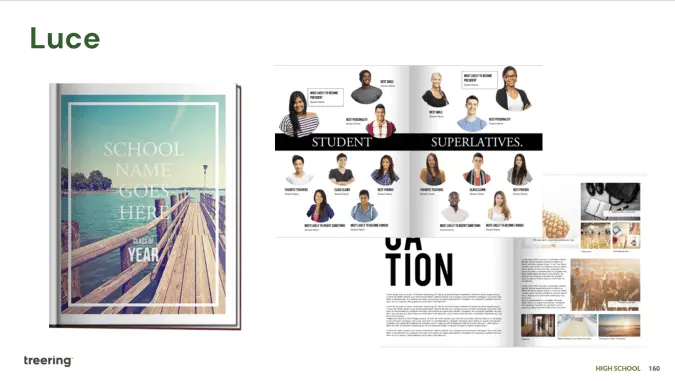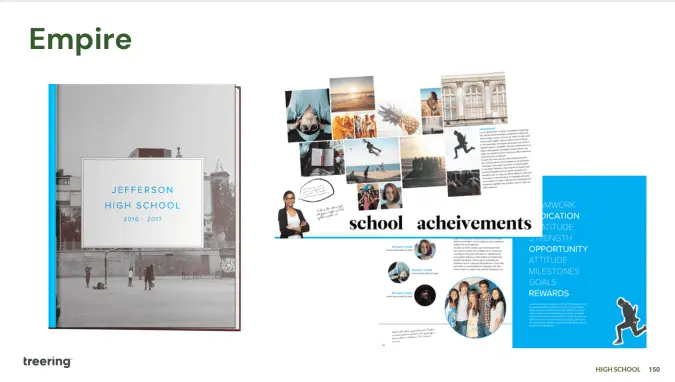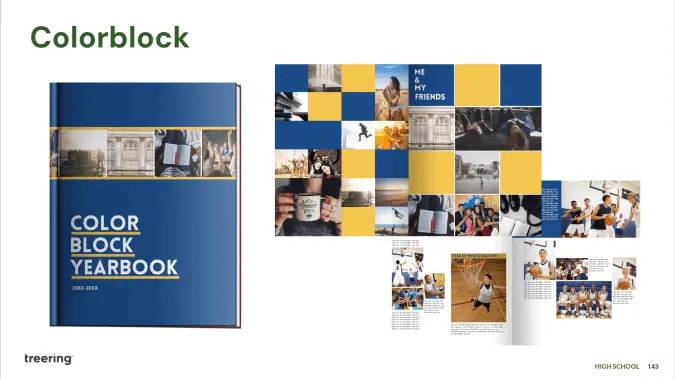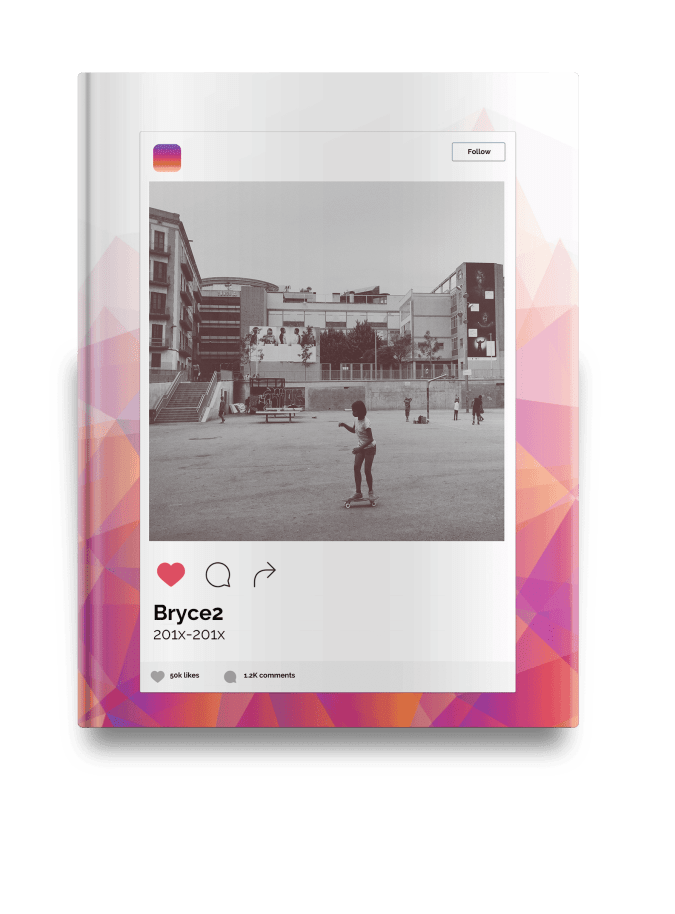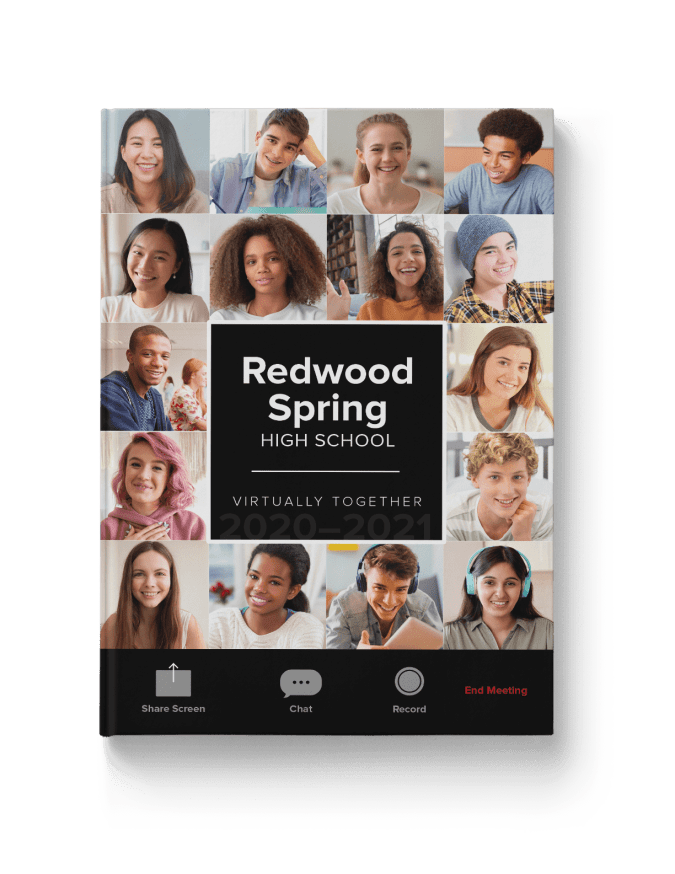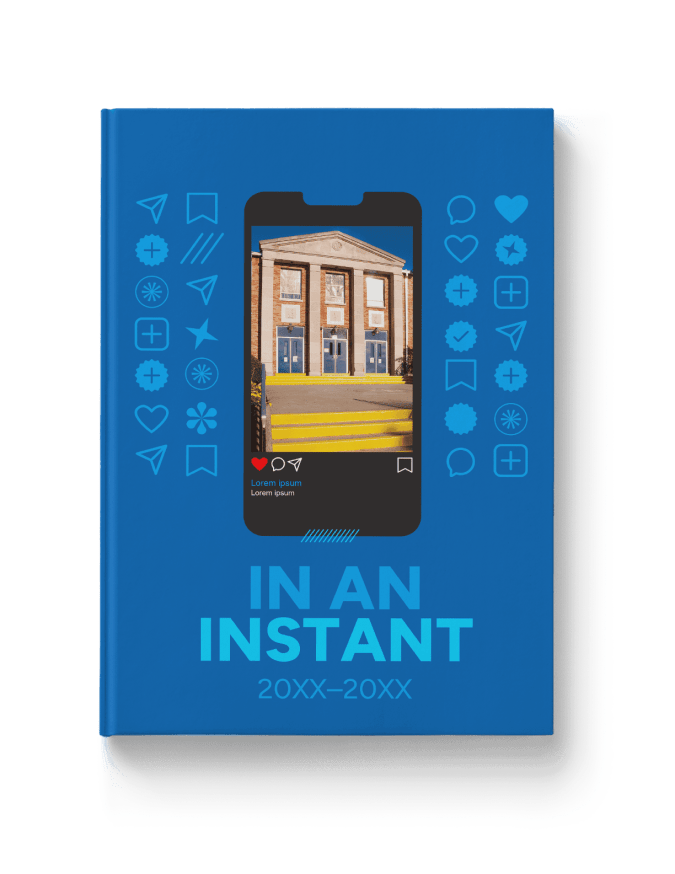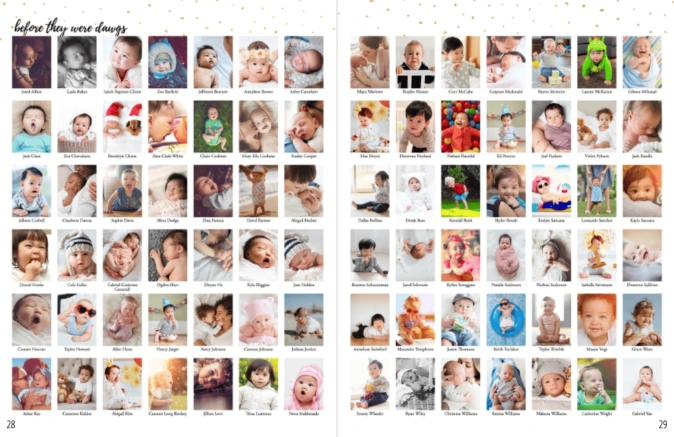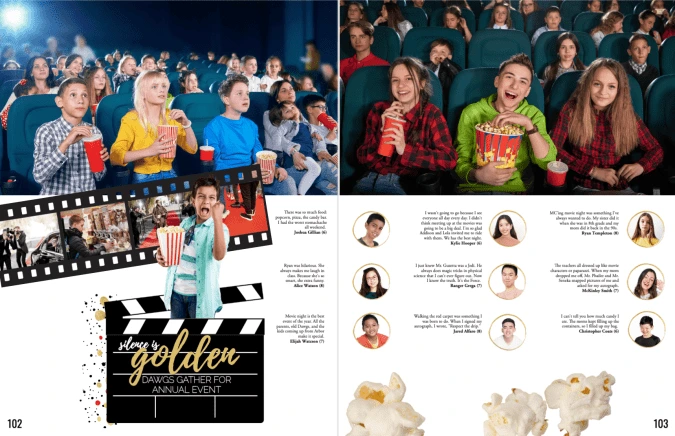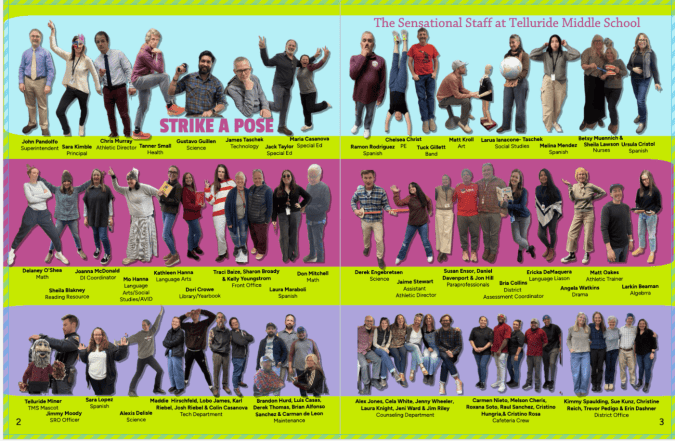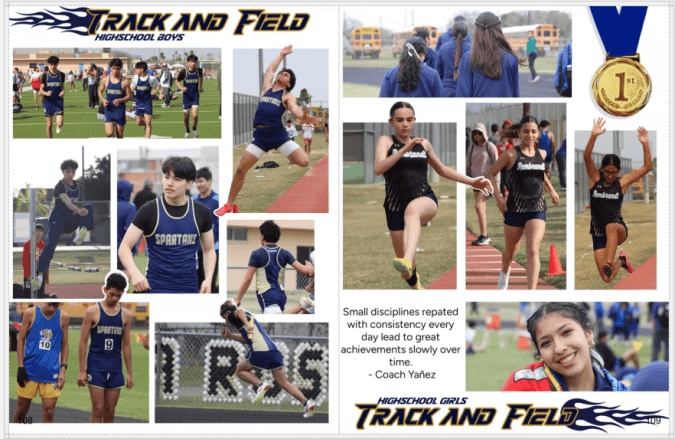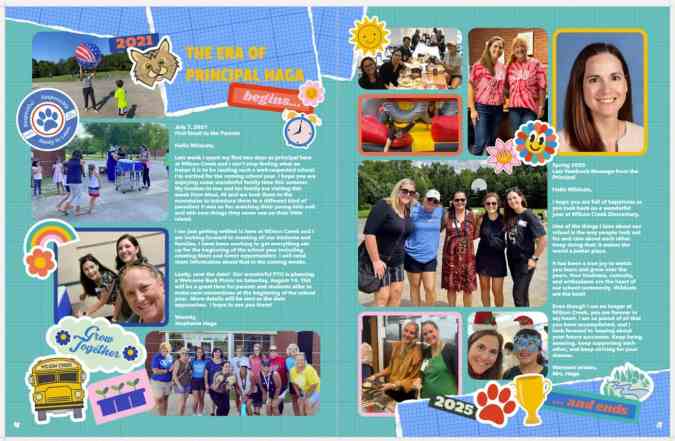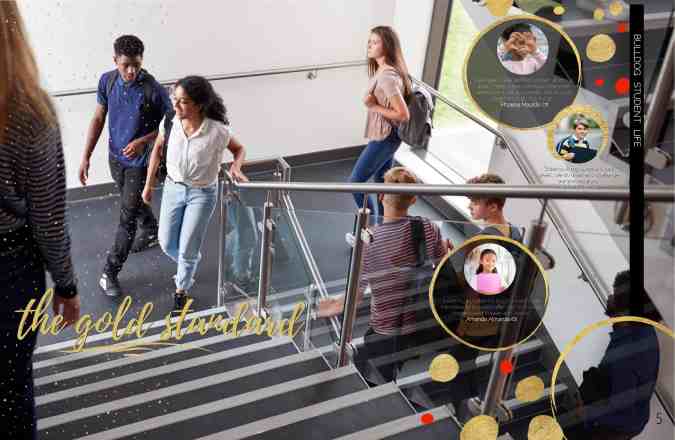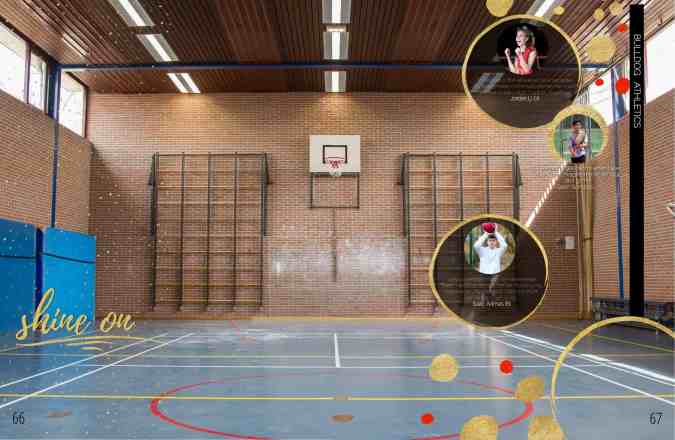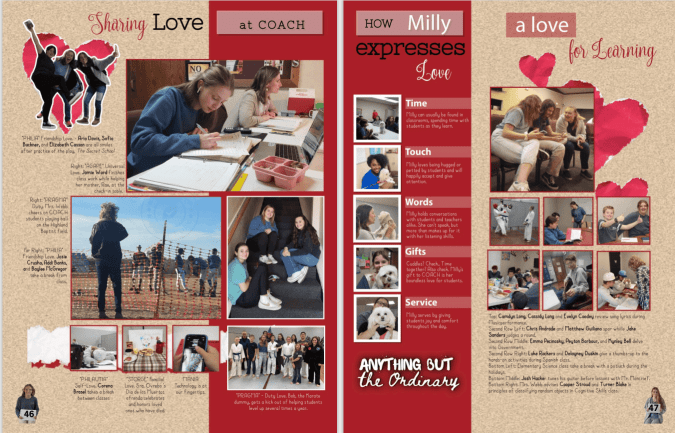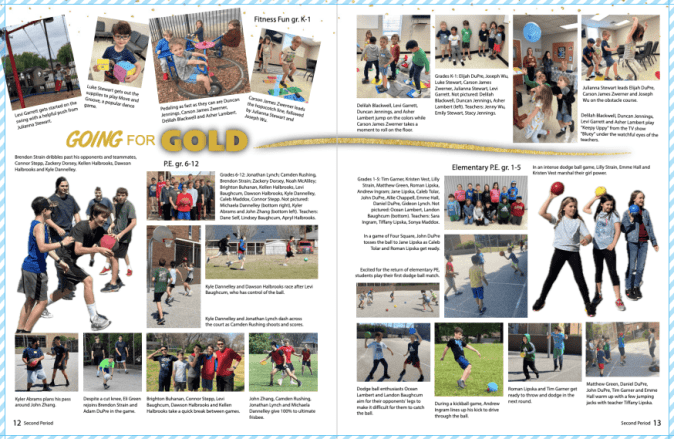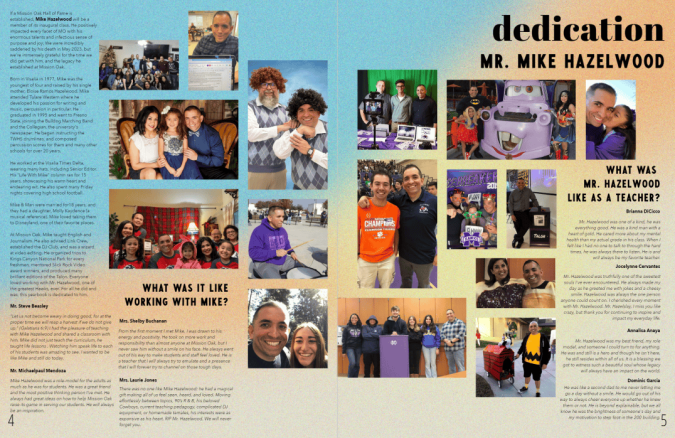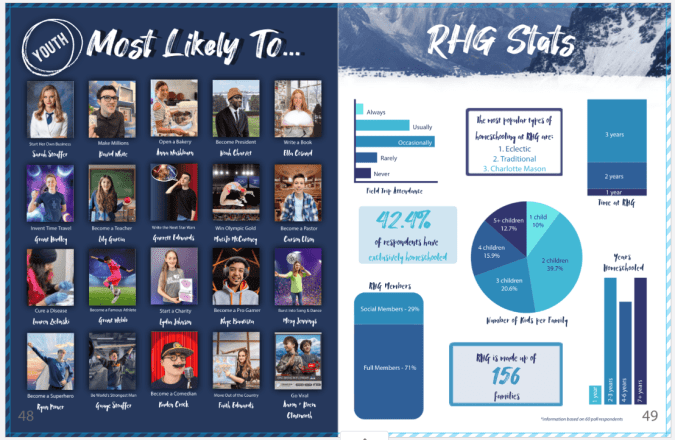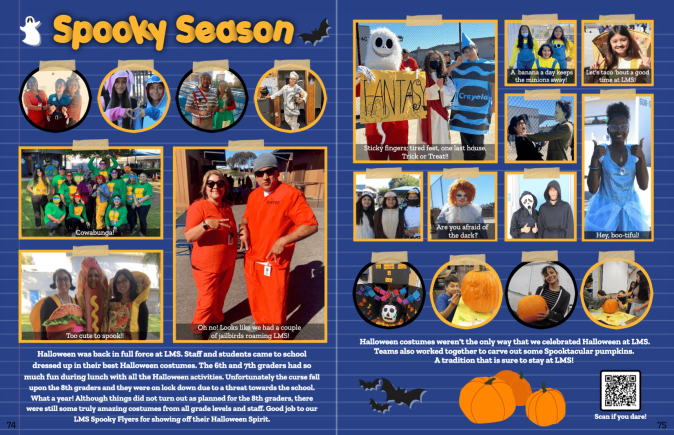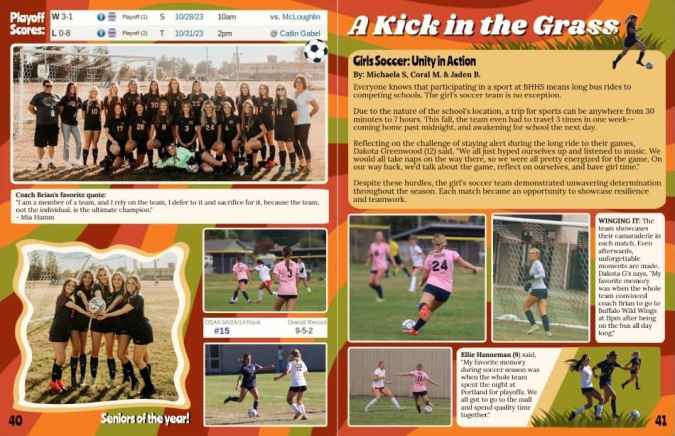Design
Looking for inspiration, design tricks, how to make a great cover, promoting your yearbook and engaging your community?
Most recent

8 things to include in your yearbook
Scroll through your yearbook ladder and try not to panic at page after page of emptiness. To help with planning, we compiled this list with the understanding that you would have the meat and potatoes of a yearbook:
New at this? Pick one or two to include in this year’s yearbook. As your tenure as an adviser grows, so can your repertoire of things to include.
1. Autograph space
This is why we throw yearbook distribution parties. It’s why we wait until the last vote is counted in the ASB election and last ribbon is awarded at field day. Three weeks after clicking “I’m Ready to Print,” boxes of books magically show up.
Autograph pages are easy to include in your yearbook: you use a pre-made template or design your own. It doesn’t have to be fancy.

2. Table of contents
This is the most underrated spread in the book, a table of contents is the must-have launch pad for the reference book that is your school annual. It’s also something that can take a few clicks to create, if you’re using a Treering theme.
3. Collage layouts
Many times, we see upwards of 60 photos slapped on a spread with no layout structure. The number of students covered is overshadowed by a chaotic layout.
https://blog.treering.com/collage-page-ideas/
PSA: Just because Treering offers layouts with up to 65 photos, doesn’t mean you should use them. Every student should be recognizable. Aim for their faces to be the size of a dime.
4. Superlatives
Superlatives—is Greg Heffley the only one who calls them “class favorites?”—are yearbook awards based on student surveys. These “Most Likely to…” awards highlight standouts.

Check out our list of 100 superlatives focused on creativity, character, and community contributions.
5. Year-in-review spread
Unless your yearbook is chronological, including a year-in-review spread is a way to increase storytelling. It gives a holistic overview of the year, both in and out of school.
School-level
A designated school year-in-review spread can feature images from events throughout the year, giving an overview of the activities and achievements across campus. Many yearbook creators love to use them for photos that may not have “fit” anywhere else or as a way to cover different students from saturated events pages.
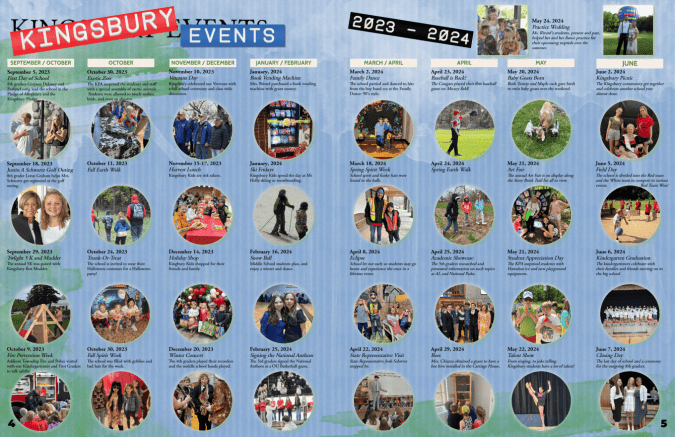
We adapted it. Search "calendar" under "all page templates" to include this in your yearbook.

World-level
Some schools include what happens beyond school walls on a year-in-review spread. To do this quickly, use Treering’s pre-designed one.

Yearbook classes and clubs that want to create their own should
Keep in mind: if your year-in-review pages include celebrities, logos, photos someone on your staff did not capture, even in educational yearbooks, you may run the risk of copyright. The Student Press Law Center has a digestible guide on fair use for student media.
6. Storytelling photos
Both classroom moments and hallway hangouts show student life on campus. It’s important to include candids, academic photos, and even lunchtime snaps to balance posed portraits.
7. Content on portrait pages
Another way to break up posed portraits is to include content on portrait pages.
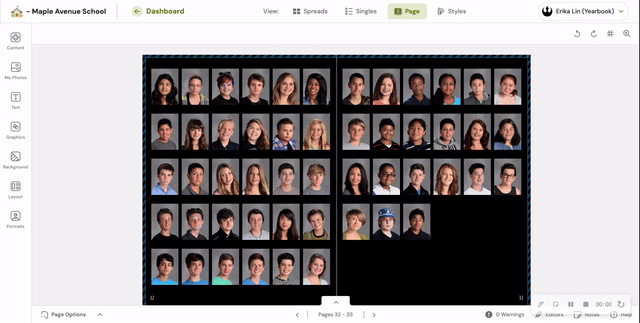
Shrinking your portraits to free up space for storytelling photos or even feature coverage, deepens your coverage and adds value to class pages.
8. Stories and captions
This is last on the list, not least on the list. Regulars to the blog have seen this charge before: If there is no writing in your yearbook, add captions.
Master them. Then, include expanded captions. Then, body copy.
No matter your team size, you can include extras in the yearbook that elevate it beyond a photo album and make the difference between a book that gets browsed and one that’s cherished.

Traditional vs. trendy
When beginning to develop your yearbook theme, the choice of a traditional or trendy theme determines the layout design and the overall feel of the book. Many see traditional and trendy as opposing ends of a design spectrum. We hope to show you how you can fuse them as you create your yearbook theme.
Traditional design
Traditional yearbooks can be timeless. Their design structure is safe and predictable, easing readers through each turn of the page. Their appeal is not limited to students: parents, teachers, and alumni also feel included.
When following traditional design, design elements such as consistency, repetition, alignment, and proximity bring beauty and order to the design. Everything has a place and a purpose.
Some may argue that traditional design takes away from creative freedom, and they opt for the opposite: a yearbook led by a visual trend.
Trendy design
Inspired by a new social media platform or pop culture movement, trendy yearbook themes can be the creative equivalent of a blank check. Graphics and layouts can be playful, dynamic, buzzworthy, or a combination of all three! The immediate response from the student body is reactive, in a good way, because a trendy theme is an in-the-moment one.
Beyond hashtag sensations, fashion and art trends may drive the visual concept. Retro, scrapbook, and organic yearbook themes capture the spirit of students. Each conceptually has an authentic vibe and pushes traditional design norms by being more aligned with a DIY ethos.
Cons of using a trendy yearbook theme
Because they are deeply connected with a visual concept, they may not be fully developed verbally, leaving the theme concept feeling unfinished. While trendy yearbook themes immediately connect with the student body, they may also quickly feel outdated.
Take a look at these three tech-inspired Treering themes. Each captures a specific moment over the past ten years: the advent of "likes," virtual classrooms, and a glow up.
How to choose?
The best way to select a visual identity is to begin with the verbal. What story do you want to tell? Why?
Think about longevity and what value you want the yearbook to have in ten years or more. Determine if you want to create another volume in your school’s legacy or capture a specific moment.
Classic and current: a blended approach
A traditional book can feel dull with page after page of safe design. Conversely, a trendy book without proper hierarchy and balance feels chaotic. That’s why we advocate for trend-forward with timeless structure; it’s the Hannah Montana of yearbooks. Traditional design grounds the book, and trends bring it to life.
Ideas to blend traditional and trendy design:
1. Font pairings: Use contrast to create your headlines
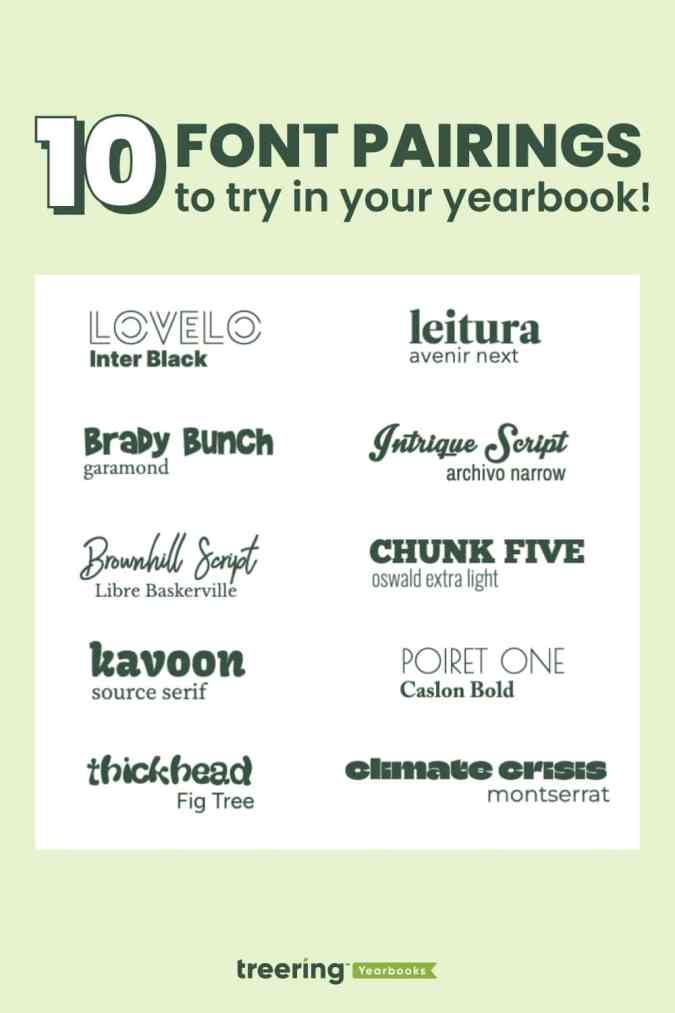
2. Color palette: Add a pop of color to a traditional color palette
3. Visual “hits”: Use up to three elements throughout the book to add variation
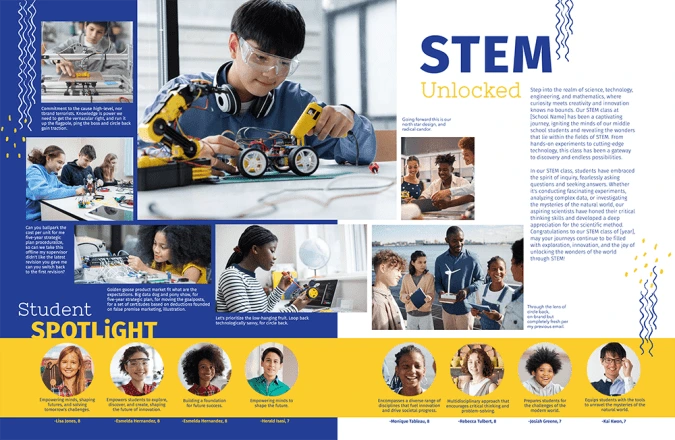
4. Showstopper spreads: Punctuate portrait pages with a highly visual spread
5. Trending treatment: Add a photo treatment to break up a traditional layout
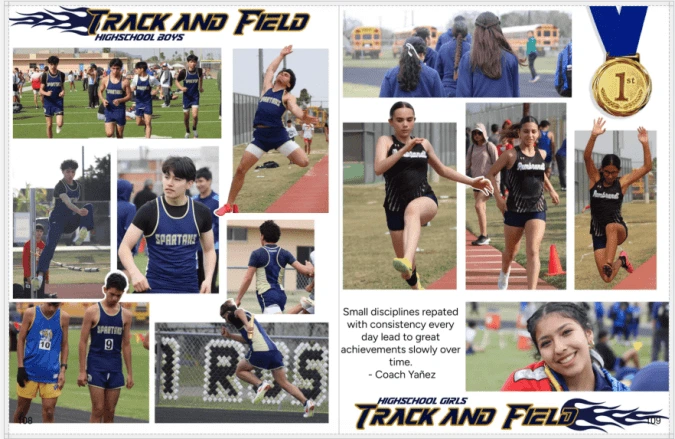
Keep in mind, great design never goes out of style. And, when paired with quality captions and copy to tell the story of the year, that’s what makes your yearbook stand the test of time.
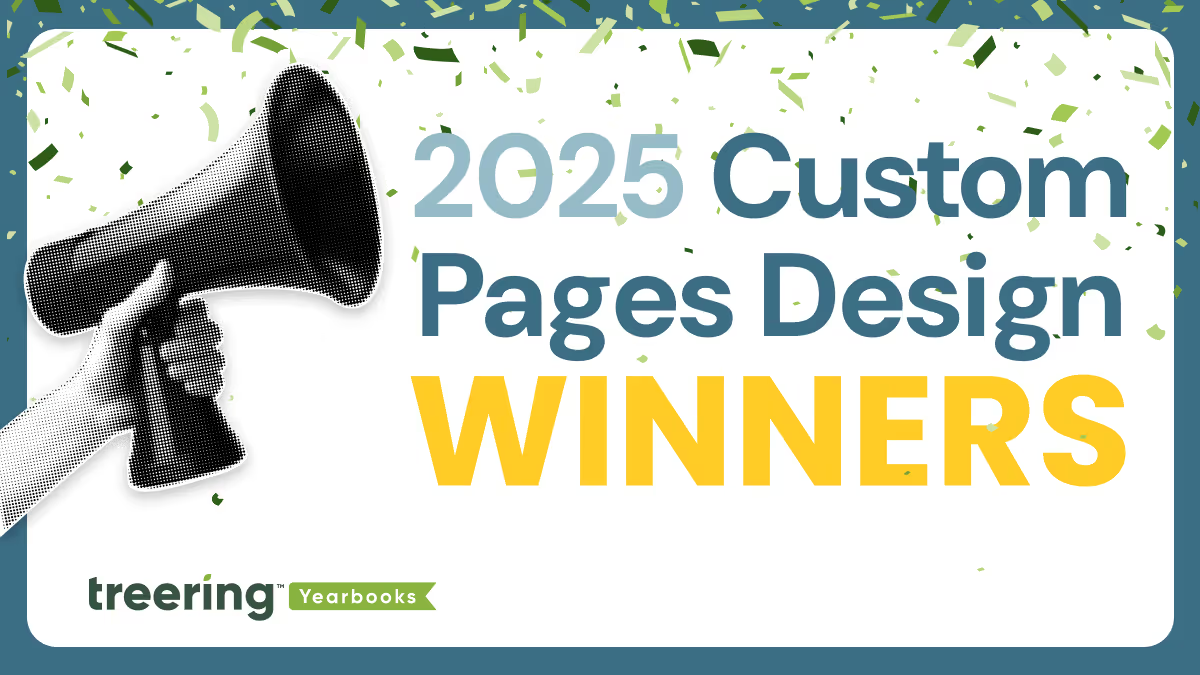
2025 custom page design contest winners
You, too, believe every child deserves the spotlight. And when you took on the open-ended challenge to celebrate in style, your creativity, honesty, and heart were on full display.
We're honored to showcase the showstopping designs and the stories of the creators who brought them to life.
Grand Prize Winner
Narrowing down over 1021 entries to the top 100 took two days. We reviewed every submission carefully, appreciating the heart behind each one. Designs that went beyond the template rose to the top because they had personal touches.
In each round of evaluations and re-sorting, one spread stood out and eventually became the $500 Grand Prize Winner.
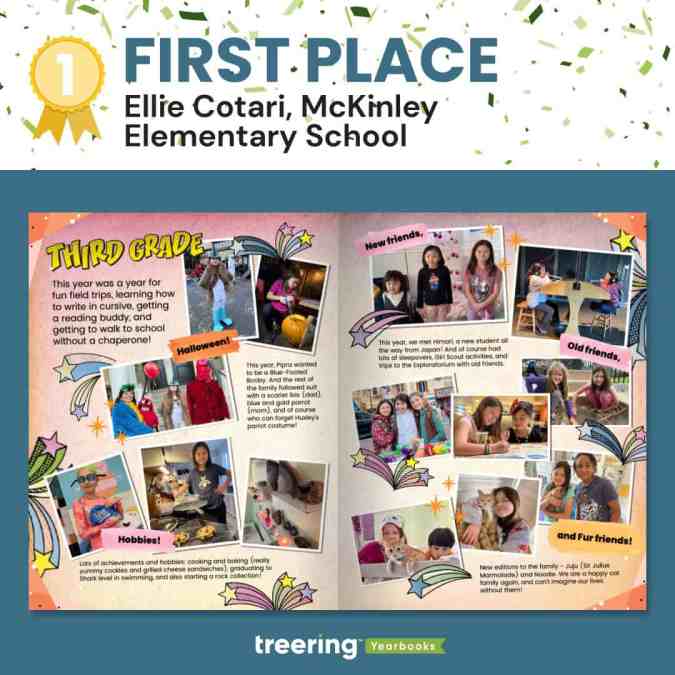
Why we loved it: It showed how design can be energetic and balanced. Both the warm colors and shooting stars are lively.
"It screams, 'third grade,'" a judge said.
And yet, with all that is going on, the main entry point is still the headline, and your eyes move in a circular pattern. There are verbal guides to highlight the five main sections. Cotari keeps it grounded by using a consistent photo style and typeface.
Cotari said, "It matches [my daughter's] personal style, hobbies and interests, and her playful personality!"
POV: People Sent their Favorite Moments and Somehow they're OURS Too!
Nearly all the submissions captured a different perspective: students shone across academics, athletics, and activities. Grandparents held places of honor and remembrance. Together, we gushed over pet pics and cried over stories of overcoming trials. Check out the top 100 submissions before seeing the Big Ten.

Thank you for embracing the spirit of Treering's custom pages and giving your child the spotlight.
Custom Page Design Contest Finalists aka the Big Ten
A group of judges combed through the top 100 to create the top 25, then top 15, and finally, the top ten. Each of the runners up earned a $50 Amazon gift card for their visual interest and originality.
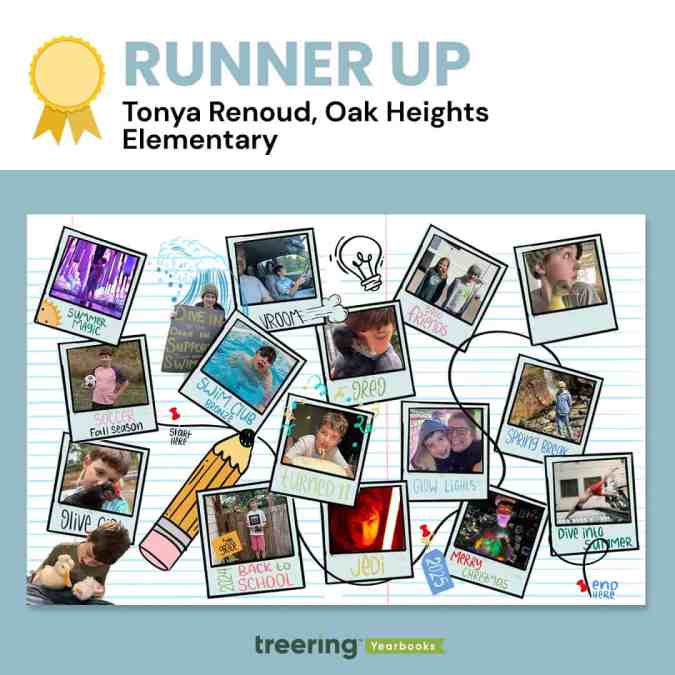
Tonya Renoud, Sweet Home, OR
Why we loved it: Renoud had us at start here.
"When he looks through these years later, he can walk down memory lane," she said.
This is exactly what she gave us. There is a path peppered with highlights from the end of summer to the start of next summer. Pets—this might be our first-ever duck submission—are especially timestamps in childhood.
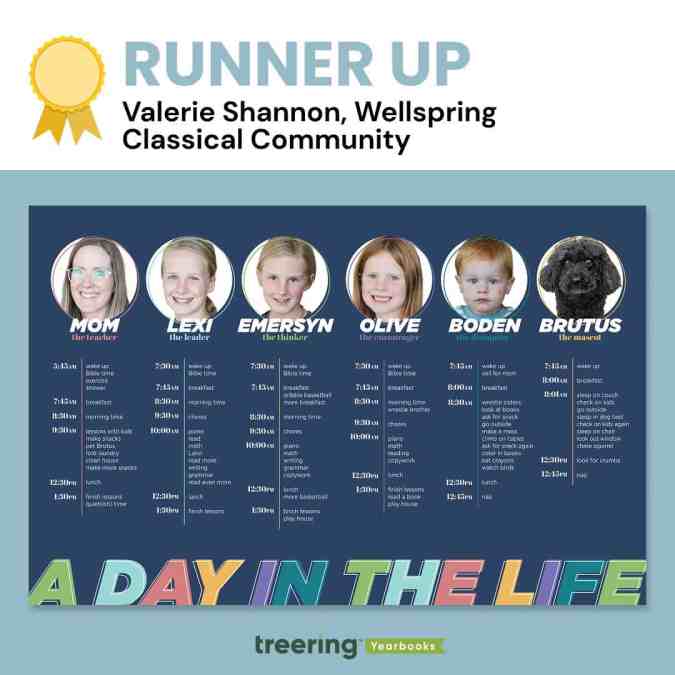
Valerie Shannon, Findley, OH
Why we loved it: Brutus and Boden.
At a glance, these two family members stand out because of their cute factor. Once we stopped to read, Shannon won us over with her tongue-in-cheek copy, which she called a "fun peek into our homeschool day."
"The theme of this year's contest was 'Every Child Deserves the Spotlight,'" a judge said, "and she managed to use her spread to give four kids, the dog, and herself a moment to shine."
Shannon's design is clean despite being full of copy. We love how she chose a color palette and anchored each family member's daily routine with one color using a tool line and circular frame. Both the frame and the knockout on the heading text are offset. It's these little details that elevate the design.
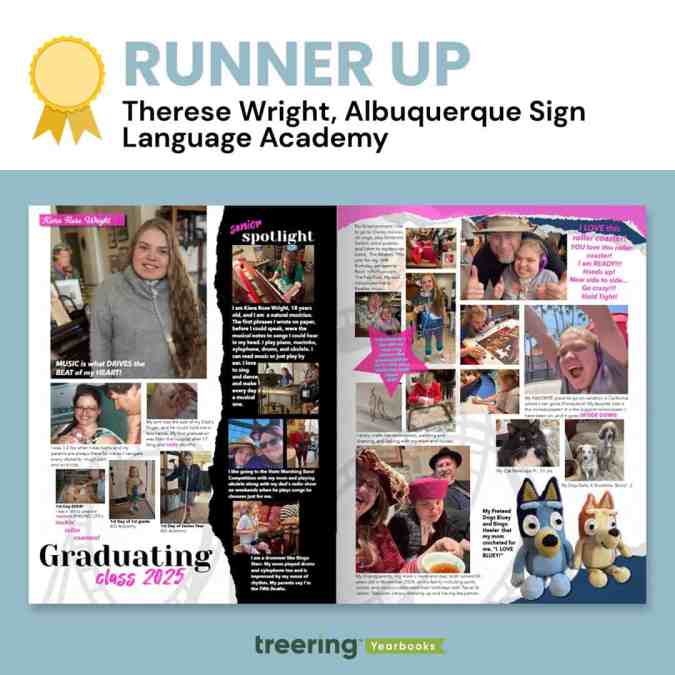
Therese Wright, Albuquerque, NM
Why we loved it: This was one of two magazine-style custom pages that captivated us. We loved the torn elements and how Wright used the black paper to highlight moments from her daughter's senior year. For Wright, these design elements held further meaning:
"Torn pages with rough edges, curving tracks, splashes of pink (representing moments of easier breathing) brighten up the darker moments that have strung these ups and downs together and keep her rock 'n rollin toward an unknown future, able to face each new challenge and sing, 'I am ready! Hold Tight!'" Wright said.
The watermarked roller coaster further illustrates the Wright Family's journey, which began with a 17-month ICU stay. Despite countless hospitalizations, communication barriers, and daily health challenges, Wright's daughter has persevered with strength and joy, communicating through American Sign Language and music.
This is the ultimate senior celebration.
"Albuquerque Sign Language Academy gave her a voice in the world and a place to belong from 1st grade to 12th," Wright said.
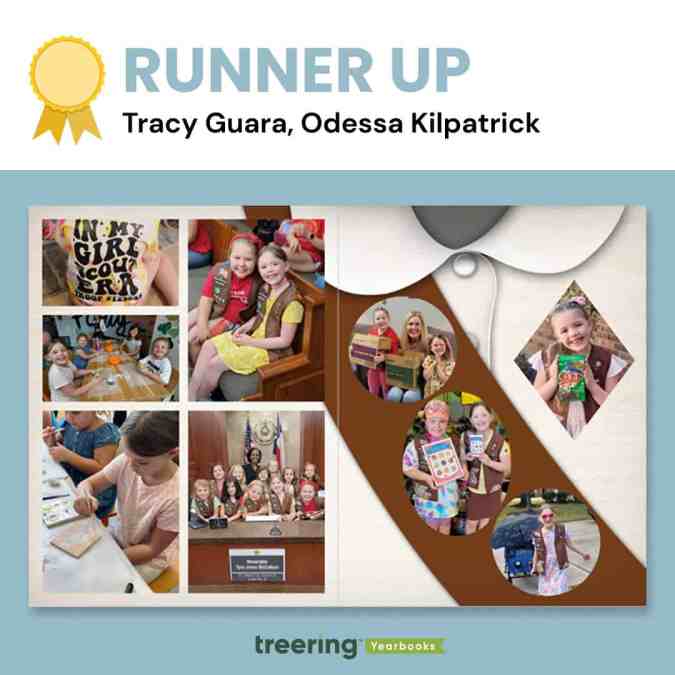
Tracy Guara, Katy, TX
Why we loved it: The photos as badges caught the judges' eyes, as many identified with this milestone as troop leaders or former Brownies.
"This is a moment in time," said a judge. "It's exactly what custom pages should be."
Guara's daughter is a fourth-generation Girl Scout who achieved badge and cookie-selling goals.
"I was honored to create this spread mimicking a Girl Scout Brownie sash," Guara said.
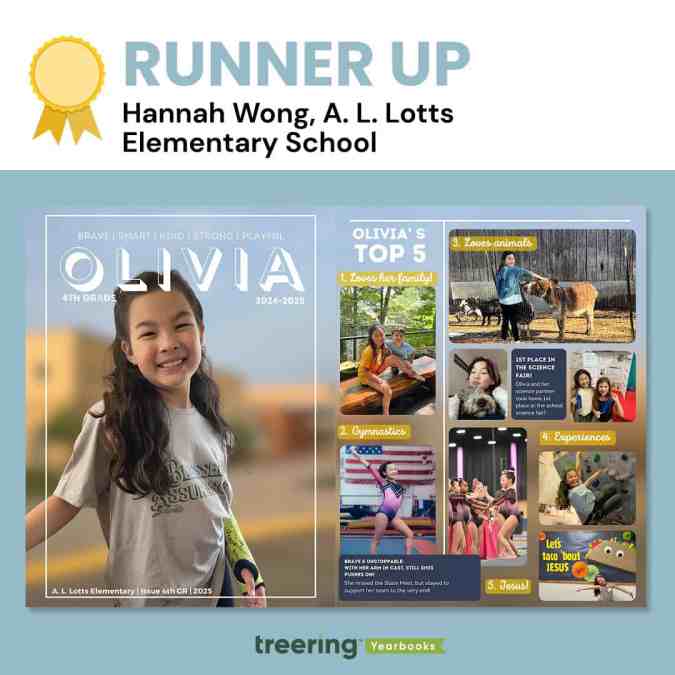
Hannah Wong, Knoxville, TN
Why we loved it: It looks complicated.
"This spread is not just a collection of photos and milestones," Wong said, "it's a heartfelt tribute to her dedication, growth, and the pride I feel as her parent."
The layers made it rich. With a single photo as background across the spread, Wong layered photos, editable shapes, and textboxes to create this magazine-inspired look. Even with all the content, she maintained alignment in her columns (the designers really geeked out over this) and pulled color from the background to connect the top five headlines.
While it looks complicated, the layout is clean and straightforward to recreate with Treering tools.

Dana Denning, Albuquerque, NM
Why we loved it: Everything points us into the spread.
Denning's choice and use of graphics here are masterful: the plane is flying toward the center, the arrow points to the center, and even the shadows on the skyline at the base of the spread lead toward the center. Additionally, her spread uses a design hierarchy we don't see outside of traditional yearbook pages.
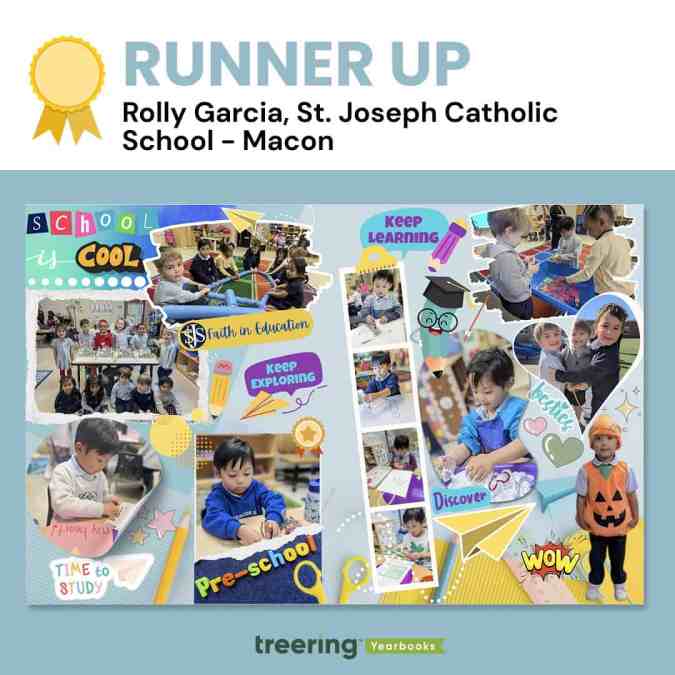
Rolly Garcia, Macon, GA
Why we loved it: It's cliche, but this spread truly put the cool in school. With playful colors, encouraging graphics, and photos of highlights in- and outside the classroom, Garcia captured the spirit of early childhood education.
"The filmstrip has those fine motor milestones in the classroom," said an educator-slash-judge. "We see pencil grip and dexterity skills developing."
Garcia said, "A notable element in the design is the paper airplane, which symbolizes the concept of 'soaring'—reflecting the idea that when students learn and grow, they are empowered to reach new heights."
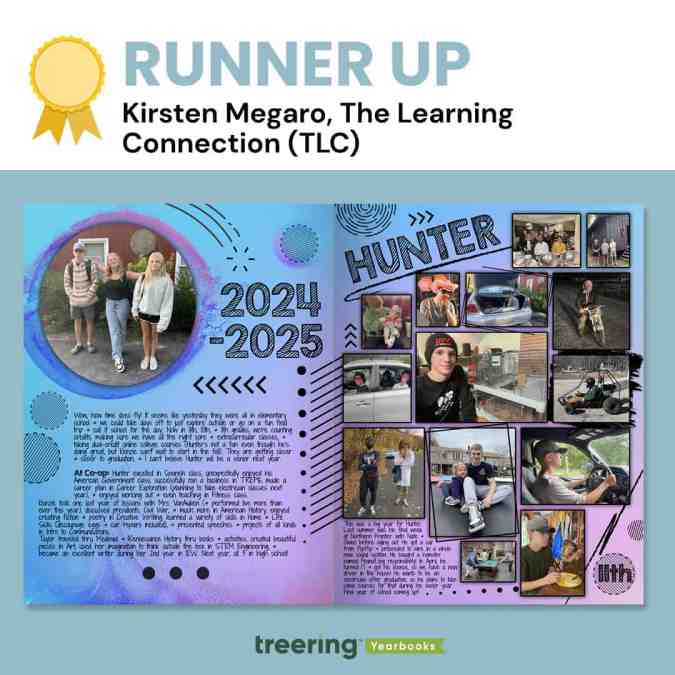
Kirsten Megaro, Great Meadows, NJ
Why we loved it: Megaro's extra touches of texture made us want second, third, and thirtieth looks.
"I know this was made in the Treering app," said a judge, "but I can't help but think it was first a pen-and-ink creation in a notebook during math class."
The judges loved the rectangle at an angle, the use of circles, and the font choices. They also emphasized the black scribbles and frames, which brought clarity to what could have been a complicated visual.
"We want to celebrate and remember the 'regular' moments of life," Megaro said, "not just the school-related stuff, so these pages allow us to do that and we love being able to look back on them from year to year."
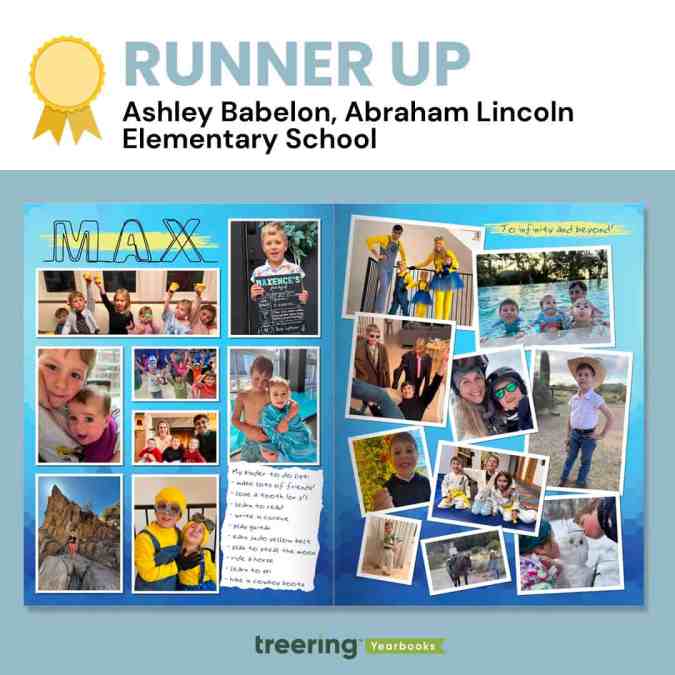
Ashley Babelon, Chicago, IL
Why we loved it: Max's kinder to-do list became an "eye spy" moment for us. We wanted to see if he ticked all the boxes. (He did!)
"Max also loves 'Toy Story' and Minions, and so the color scheme and font act as a mini time capsule of the things our little boy loves right now," Babelon said.
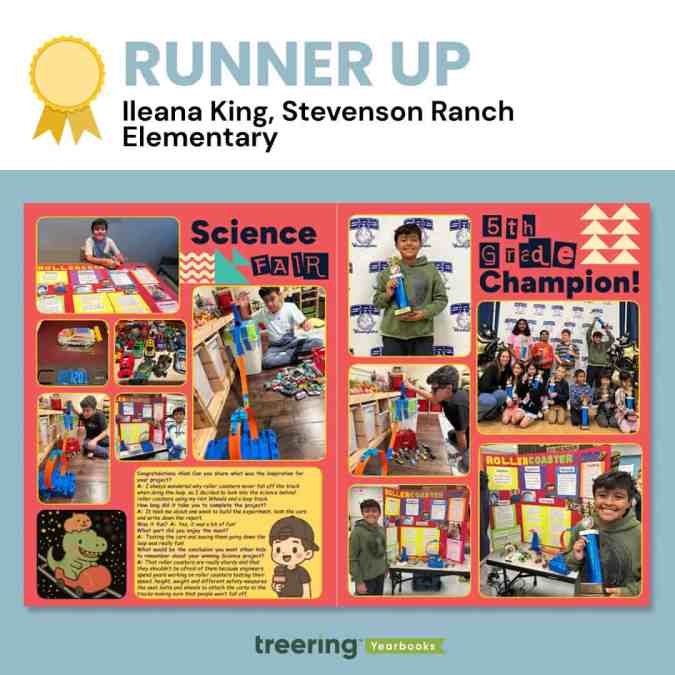
Ileana King, Stevenson Ranch, CA
Why we loved it: From the interview to the before-during-after photos, we loved the depth of coverage on this spread.
King said, "To add a fun twist, I used AI to create the sticker of a capybara and a T-rex, two of his favorite animals, riding a roller coaster. Then I added Treering graphics to make it look like Space Mountain, which is my son's favorite roller coaster."
One of the judges said, "This is one of the things you pull out when a future daughter-in-law comes over."
Thanks to all who entered and shared their story with us.

Scrapbook yearbook themes
Scrapbooks are deeply personal and emotionally charged. They’re where Millennial moms stash ticket stubs, scribbled notes, and snapshots. Students also lean towards the collage aesthetic via pop culture inspiration—like the Burn Book in “Mean Girls” or My Adventure Book in “Up.”
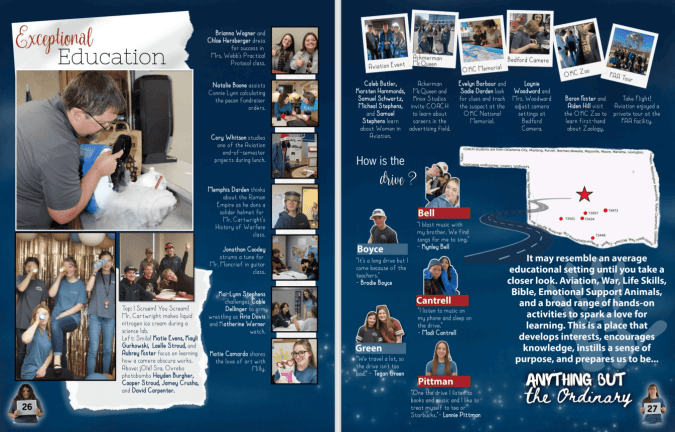
While the Burn Book itself is not the kind of sentiment you want to capture in a school yearbook, its visual style has inspired many scrapbook-themed designs: magazine cutout lettering, sticker overload, and chaos-meets-craft aesthetic speak to the way students envision personal memory books.
Likewise, Carl and Ellie’s book is a love letter to scrapbooking itself. It balances whimsy, sincerity, and nostalgia. (We’re not crying. OK, maybe a little.)
Three free Treering themes to get the scrapbook vibe
One of the best parts of the scrapbook yearbook theme is its flexibility. You can up the visual intensity depending on your staff’s skill level and your community’s taste. We have three complete yearbook themes that model scrapbook yearbooks.
Because a scrapbook style mimics personal journaling, students feel connected. It looks like their notes, their lockers, and, to an extent, their social feeds. The collage-inspired layouts also let you pack in more visual content, perfect for schools that crowdsource images from parents, staff, and students.
“Crafted” - intro to the DIY aesthetic
The 75 pre-designed templates have built-in white space and subtle borders, which gives a clean scrapbook look. The 64 graphics, which include a variety of torn papers and tapes, allow teams to add variety and rough edges. This look works well for journalistic high school books that want polish with personality.

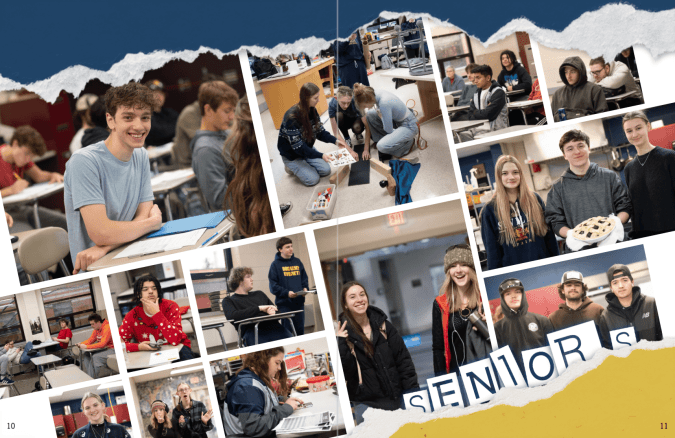
“Collage” - scrapbooking to the max(imalist)
Lean into creative chaos with 862(!) design elements. This theme mimics a real-life scrapbook packed with overlapping images, ripped notebook paper, buttons, stickers, and magazine-style clippings. Because it is a maximalist look, you can create unity among the varied elements by

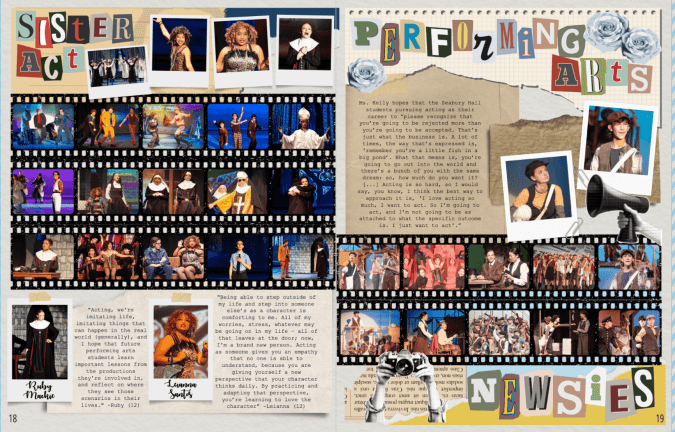
“Venture” - the vintage journal
Inspired by antique books, this yearbook theme includes 100 aged paper backgrounds plus 616 graphics including typewriter keys, delicate handwritten fonts, antique elements, and photo corners. The textures and photorealistic elements work well in layers with a handwritten or type-writer font. Like the maximalist approach above, remember the rules of design to keep it from looking cluttered.


A scrapbook yearbook theme works at any level, elementary, middle, or high school. It can look rustic and handmade. Retro and analog. Colorful and chaotic. Minimalist and soft. The best part? It doesn’t lock you into a single aesthetic—it's more of a concept than a rulebook.
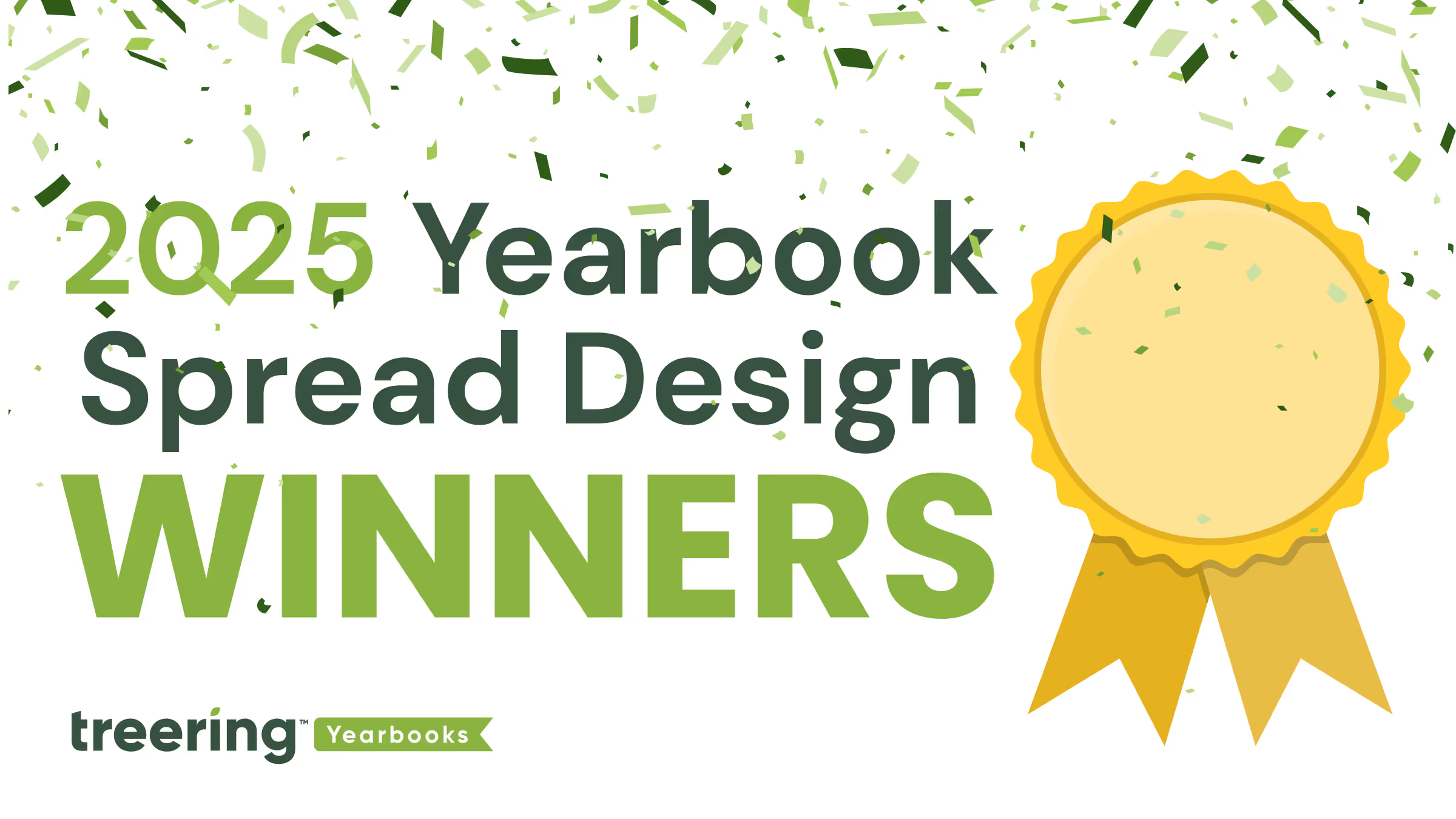
Winners of the 2025 spread design contest
We asked you to “show us what you got” and you understood the assignment. The diversity of subjects—portrait, divider, baby photo, staff, senior tributes, superlatives, arts, and athletics spreads—coupled with the styles, themes, and narratives left us inspired.
Thank you.
It sounds cliche to say it was tough to comb through hundreds of submissions, read your stories, and examine everything from how photos were cropped to how they balanced across the spread. But you delivered quite the challenge.
A panel of yearbook and design professionals, PTA parents, and journalists looked through every submission in a blind judging. They evaluated your submissions on
- Layout design
- Storytelling
- Visual elements and their relevance to content
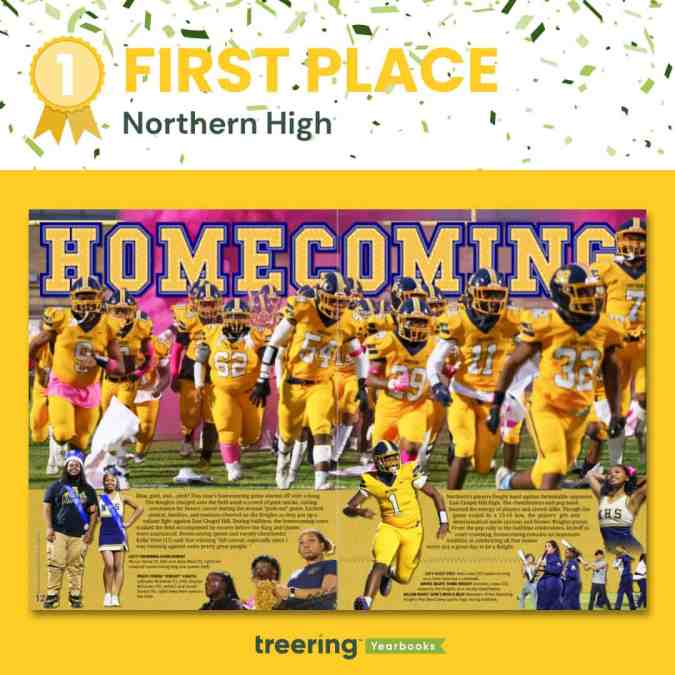
Grand Prize Winner: Northern High School, Durham, NC
Remember those prom dress-I’ll-know-when-I-see-it vibes? That was our impression of Northern High’s homecoming spread. It was unanimous. As soon as the panel saw this spread, “This is it.”
The “Polaris” staff at Northern High earned ten free yearbooks, a $500 Amazon gift card, and a $200 pizza party to enjoy as a staff.
“Our goal is twofold: To show that we are all part of our school community and school culture and to illustrate that there's more to us than meets the eye,” junior Nourriah Scott said.
Their yearbook theme, “All 'N' the Details," is both traditional (check out the classic typography) while adding modern design elements. Their theme goes beyond the visual and uses the narrative to showcase all aspects of an event.
“As the viewer travels through the spread,” Scott said, “they learn there's more to it: the court, the cheerleaders, the band, the crowd. Homecoming is just a single event in the course of an entire school year, and look how many people and parts of our school are involved in making it magical.”
Why we Loved this Design:
The details emerge once you get beyond the wow factor from the colors. Homecoming is written in a font similar to a letterman’s jacket and, as the main entry point to the spread, is behind the football team. This is a student-first design.
Additionally, the use of COB (cut-out background) photos enhances the design. The yearbook team positioned the sharp edge in the gutter and used a gradient to fade out the other.
Design hierarchy also played a key role. The story crosses both pages, bolded ledes give the reader even more entry points, and candid photos highlight all the participant groups. They indeed are “All ‘N.”
Bonus: As a Title I school, the “Polaris” staff does not have access to Adobe or other paid design tools. They created their winning spread using the Treering yearbook builder and free, web-based photo editing tools.
Runners Up
For hours, we had a solid 26 spreads on display and our panel highlighted the merits of each. When we returned to the original judging criteria, five emerged. In alphabetical order by school name, the following schools each earned three free yearbooks and a $50 Amazon gift card.
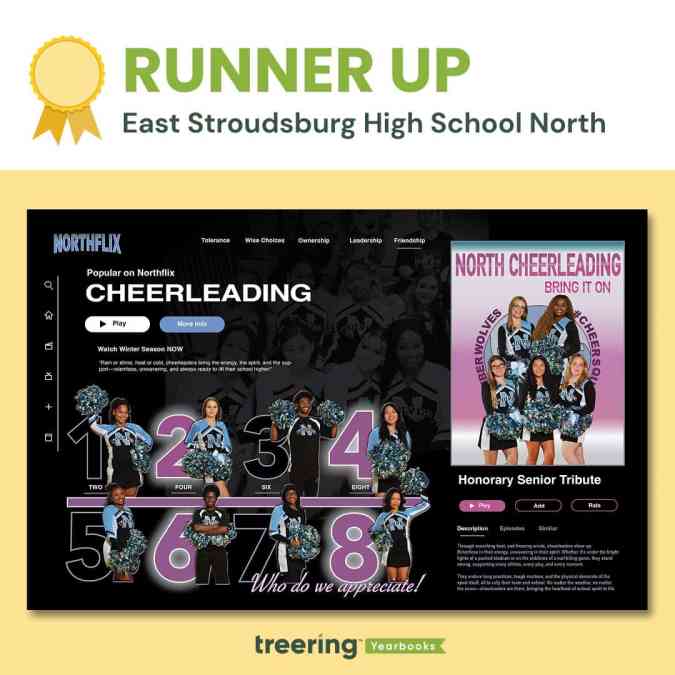
Finalist: East Stroudsburg High School North, Dingmans Ferry, PA
While this isn't the first time we've seen a streaming media look, it is one of the best iterations. The team at ESHSN used the cheer individual photos to create a movie poster on the right and recapped the season as the program description.
Across the top are the TWOLF values “intended to promote the application of knowledge, develop healthy identities and decision-making skills, achieve goals, manage emotions, show empathy, and establish healthy relationships,” Adviser Keisha Agard-Thomassine said.
Why we Loved this Design
One word: color. The school color is front and center in a spread centered around the spirit-makers. Timberwolf blue is used on the yearbook logo and as a button. The analogous purple makes it pop further.
“We beam with pride over here,” Agard-Thomassine said.
The subtle detail of the group photo in the background adds another layer of complexity to a bold and balanced spread.
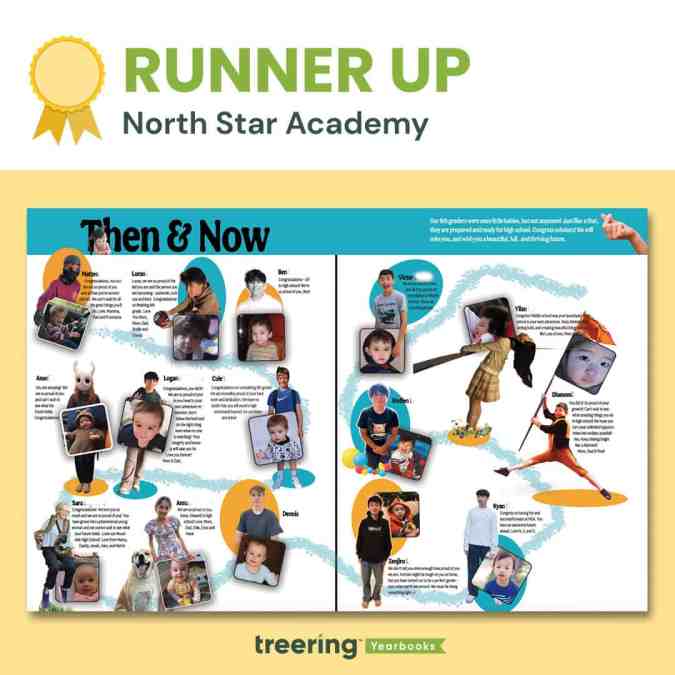
Finalist: North Star Academy, Redwood City, CA
Without seeing the entire book, you know there is a strong connection to theme: the aqua and goldenrod ovals and bold typeface are evidence of a solid style guide.
Adviser Carol Landers has a class of 30 students in grades 4-8 who help work on the book. She reserved this tribute to promoting students for herself.
Why we Loved this Design
Each eighth grader had their moment to shine with both a personality photo and a baby photo. Landers said parents contributed “photos of their students holding an object or pet or doing an activity that is important to [them].”
This highlights each student individually while using the promotion year 25 as the thread that connects them. Brilliant.
Landers employed a Google Form to solicit submissions from parents, and she’s planning ahead: “I just learned about Treering’s ‘secondary photo’ feature, so I look forward to trying that out next year.”
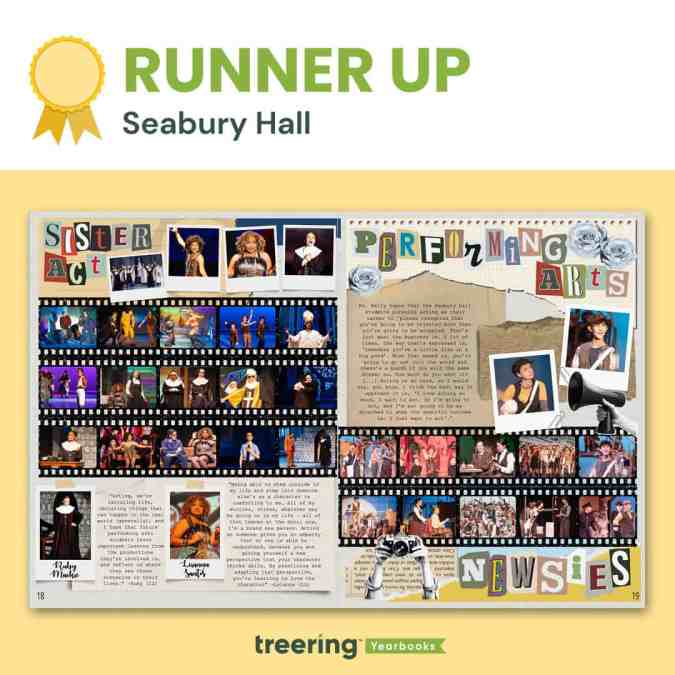
Finalist: Seabury Hall, Makawao, HI
“This spread is not just a collection of memories but a tribute to the dedication and creativity of Seabury Hall’s performing arts program,” designer Ethan Berry said, “preserving moments that will inspire future generations.”
Adviser Dakota Grossman is proud of Berry, a sophomore, who worked on this page solo. She said she helped in the brainstorming phase, and this is just one of his designs for Seabury Hall’s scrapbook-themed yearbook.
Why we Loved this Design:
Grossman said, “[Berry] truly paid attention to every detail—there's meaning behind every photo, graphic, and sentence on that page.”
That intentionality appears in the second, third, and fourth looks: beyond the colors, layers, and texture are student voices, photos of the cast in action, and a passionate narrative from the program director.
Visually, it is stunning. The narrative is compelling.
We wholeheartedly echo Grossman’s pride in Berry.
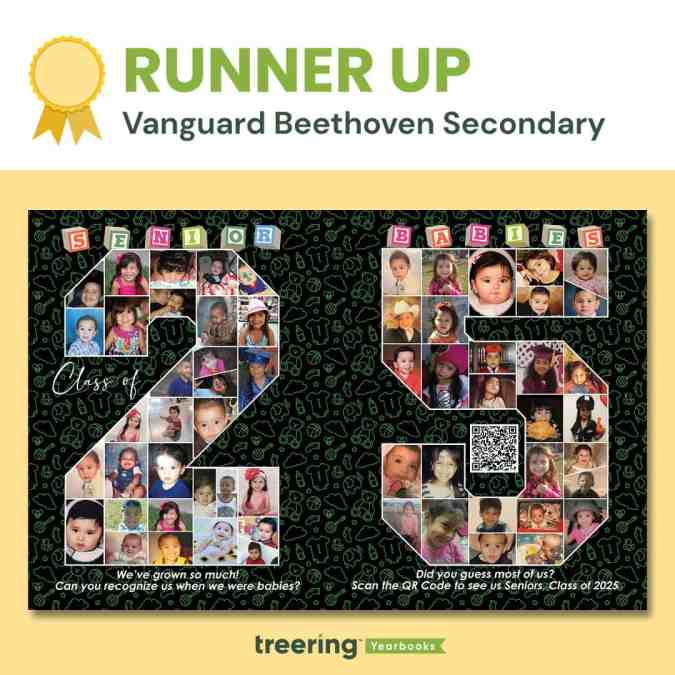
Finalist: Vanguard Beethoven Secondary, Pharr, TX
Bright, nostalgic, and playful, this spread is a showstopper. Baby photos capture the earliest moments of every senior’s journey, making this spread a heartfelt tribute.
Why we Loved this Design:
Aguilar’s vision is to blend a traditional yearbook with a multimedia presentation for the 58 seniors on their growing campus.
“The plan was to scatter all senior baby pictures,” Aguilar said. “I took it to the next level and created a media slideshow and have a QR [code] for everyone to view.”
It’s an elevated take on a yearbook classic. And we’re here for it.
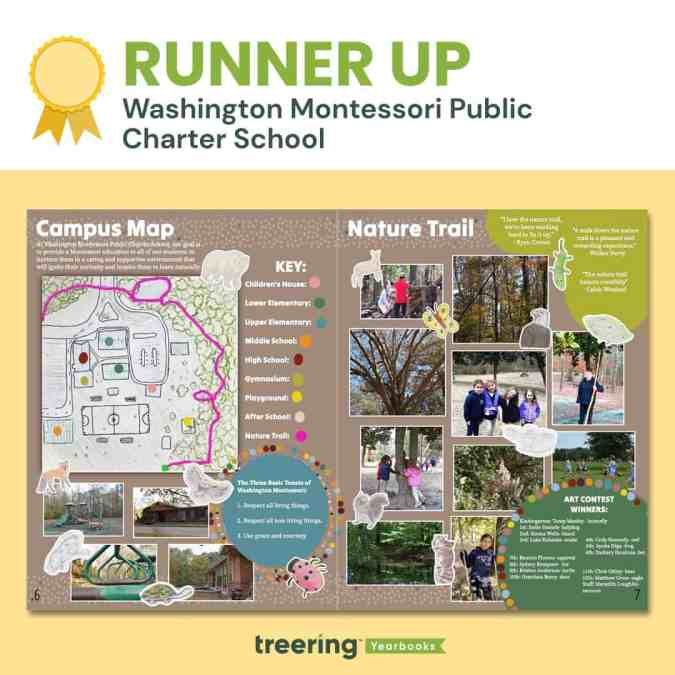
Finalist: Washington Montessori Public Charter School, Washington, NC
Senior Cadence Mallette’s creation could not go in any yearbook. This is uniquely WMPCS. She organized the yearbook team to capture student art, photos of the school and students interacting with their environment, student quotes, and a campus map. If that were a to-do list, it would look overwhelming.
Mallard made it work.
Why we Loved this Design:
We loved the mixed-media approach to this spread. Students in grades kindergarten through 11 submitted animals that share their habitat with WMPCS. Seniors drew the school mascot, a bald eagle. The winners made it on the spread.
Adviser Meredith Loughlin said this approach “united our yearbook group members while connecting them with our local ecosystem.”
This focus on unity also made it a winner. Sometimes, K-12 communities create separate upper and lower school content. Mallette’s design gives us a picture of whole-school approach.
Honorable Mentions
Because that’s not enough yearbook design inspiration, we want to call out these brilliant designs from elementary, middle, high, charter, and home schools.
Academy Days Co-op, Alliance Ouchi-O'Donovan 6-12 Complex, Alliance Renee and Meyer Luskin, Academy High School, Alma d'arte Charter High School, American Community School, Ancheta Academy, Assumption Catholic School, Atlanta Speech School - Stepping Stones, Atsa' Biya' A'ZH Community School, Auburn Hills Christian School, Avalon Middle School, Azle Christian School, Brush Middle School, Camas Connect Academy, Carencro High, CHESS Christian School, Chesterton Elementary School, City Garden School, Classical Conversations Folsom, Coconut Creek Elementary School, Cranberry Area High School, Cunha Intermediate School, Davis Intermediate School, Delhi High School, East Moline Early Learning Center, El Sobrante Christian School, El Tejon Middle School, Foothills Community Christian School, Fort Fairfield High School, Frank Bergman Elementary, Franklin Elementary School, Frederick Douglass High School, Frost ISD, Gate City Elementary, GEMS World Academy, Ghidotti Early College High School, Glencliff High School, Global Impact Academy, Global Impact Academy STEM High School, Heritage Christian School, Hilger Higher Learning, Hinsdale Elementary School, HomeWorks, HOPE Christian Academy, Indian Prairie Elementary School, John Glenn High School, Joyful Journey, Kennedy Middle School, Lakeside Christian School, Lakeside Elementary, Liberty Christian School, Maple Manor, Marfa, Marsh Grammar School, Martin J. Gottlieb Day School, Mary Morgan Elementary School, Maywood Center for Enriched Studies, Meiklejohn Elementary, Midland Elementary, Miraglia's Globetrotters, Mt. Everett Regional, NJWT New Jerusalem Worship Temple, North Bergen High School, O'Farrell Charter School, Options For Youth, Oxford Hills Comprehensive High School, Pinewood Intermediate, Pioneer Junior High, PRCES, Prune Hill Elementary, Quail Run Elementary, Rincon, University Marching Band, RISE HS, Rocky Mountain Classical Academy, Rocky Mountain Deaf School, Roseville Pathways, Ruth Batson Academy, Sacred Hearts School, Shatekon Elementary School, Shirley Hills Primary School, Smith Community Christian Co-Op, Soldier Hollow Charter School, Soldotna High School, South Orangetown Middle School, St. Jude Catholic School, Stratford Schools Fremont Boulevard, Stuart Paddock, Students On Academic Rise (S.O.A.R. High School), Swansea High Freshman Academy, Tandem Friends School, Tenor High School, Tenor High School | Cathedral Square Campus, TGU Granville, The Learning Connection (TLC), The Nova Center, Thomas J. McMahon Elementary School, Thomas Russell Middle School, Tri-County Homeschoolers, Victor H. Hexter Elementary, Vista del Mar, Wallace Elementary, Washington Middle School, Westlake Elementary, Westmont Jr. High School, Westside Global Awareness Magnet, Willett Elementary School

Designing divider pages
Yearbook divider pages are just that: they divide the book topically. Generally showstoppers, these spreads share similar layouts as they introduce the content within while reinforcing the yearbook theme. While they aren’t the pages over which students argue for editing rights, they hold deep editorial power. Divider pages enforce the book’s identity while giving each section a voice.
Use Dividers to Develop Your Theme
Yearbook theme development starts on the cover and flows through the book visually and verbally. It wows on designated theme pages. These pages include
- Opening and closing
- Table of contents
- Divider pages

Independent of the book, these theme pages form a cohesive “brand” package for your year. They repeat and reflect cover elements. They have the same voice. They develop the story of the year through copy and visuals. Each divider reflects the theme and shows how it impacts that section.
Do epic dividers mean you no longer have to include theme elements throughout the book? Think again. They’re just one more way to level up your design.
An Example from Magnolia Middle School
From the start, the book is gold and black, with pops of the school color, red. The simple title page has the theme "Stay Gold" and the school information. The iconic 50-year-old Magnolia Grove walkway is the only original part of the school remaining after a major renovation. The yearbook team re-visits the grove for the closing page.
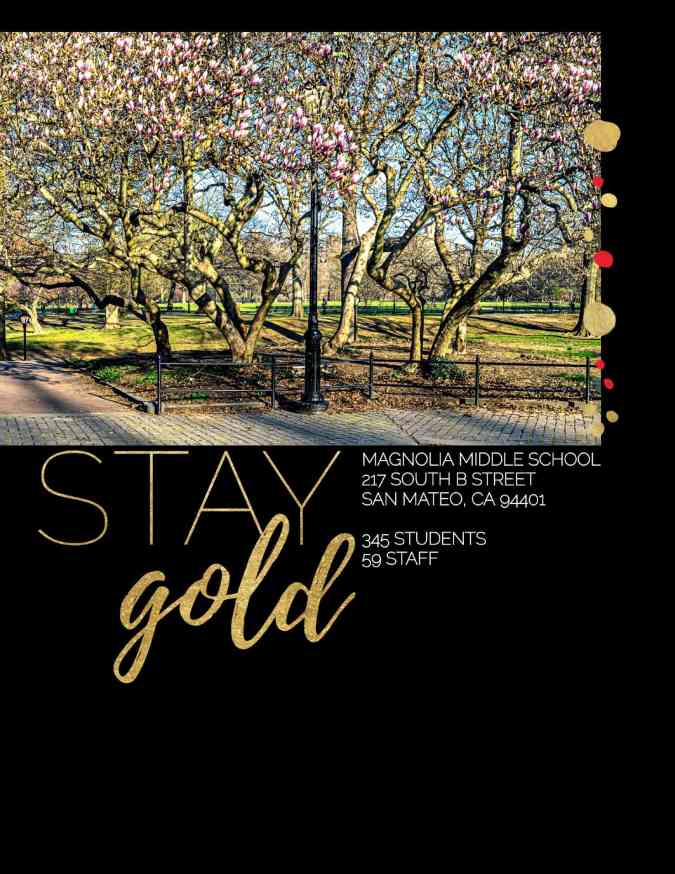
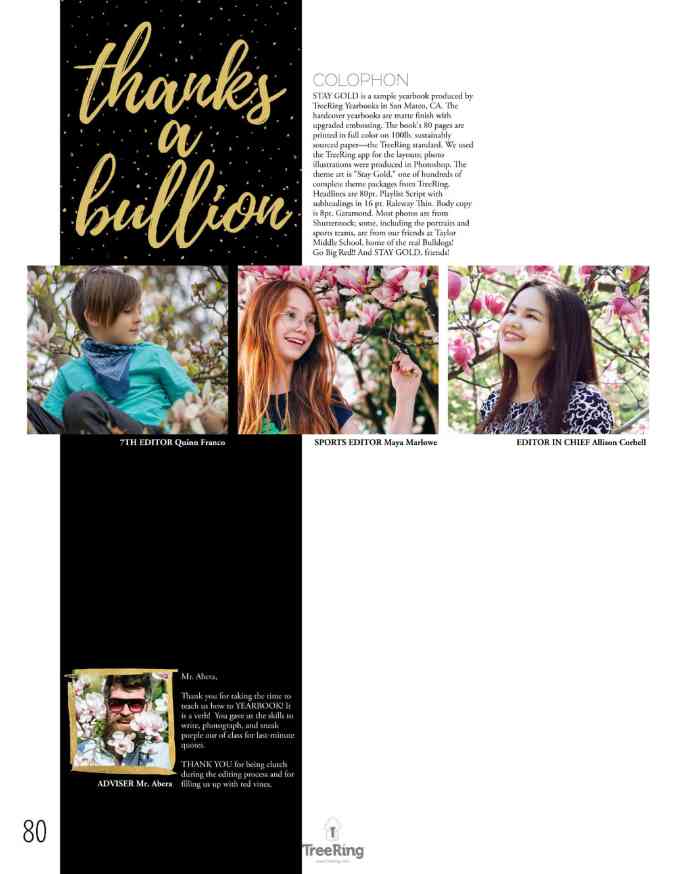
Here are the divider pages. Notice how they created a unified narrative:
- Magnolia repeats key elements: script font, circular callout for pull quotes, and gold dots.
- The new building is the visual feature and showcases how students impact each area.
- Wordplay: “The Golden Age of the Bulldogs,” “The Gold Standard,” “Shining Example,” “Shine On,” and “Thanks a Bullion” all tie back to the book’s theme, “Stay Gold.” (Fun fact: the book is built using Treering’s free yearbook theme with the same name.)
Essential Yearbook Sections
Like a table of contents, divider pages help readers navigate the yearbook. They help reset and refocus readers.
Most yearbooks include designated sections for
- People (portraits)
- Academics
- Student life
- Organizations and clubs
- Athletics
- Reference (index, ads, and teams)
You may further divide with lower/upper school, fall/winter/spring sports, or even subject dividers for larger campuses.
Creating Divider Pages
Consistency is key when designing divider pages, OK any yearbook spread. While each divider should highlight a unique section, they should all share common design elements to maintain a cohesive look. These elements can include using the same fonts, color palette, and layout style across all dividers. Repeating theme elements, such as graphics or photo styles, help reinforce the yearbook's identity while keeping readers oriented.


Yearbook in 60 days - part 1: yearbook quickstart
Two types of people start a yearbook towards the end of the school year: those handed the crown minutes ago, and those with hundreds of other tasks for the school and now have “free” time to begin one more. Creating a yearbook in 60 days is doable. Promise. We’re breaking it down for you in four parts, each with two weeks' worth of tasks and inspiration. Consider this your yearbook easy button.
Throughout the series, there will be resources for inspiration and help. Watch this quick video to see
- How to log into the Ediotr Help Center for exclusive step-by-step articles
- Where to find resources to share with parents
- Where to get design inspiration, lesson plans, and more
Yearbook (yes, it is a verb) along with us on Facebook, Instagram, and TikTok.
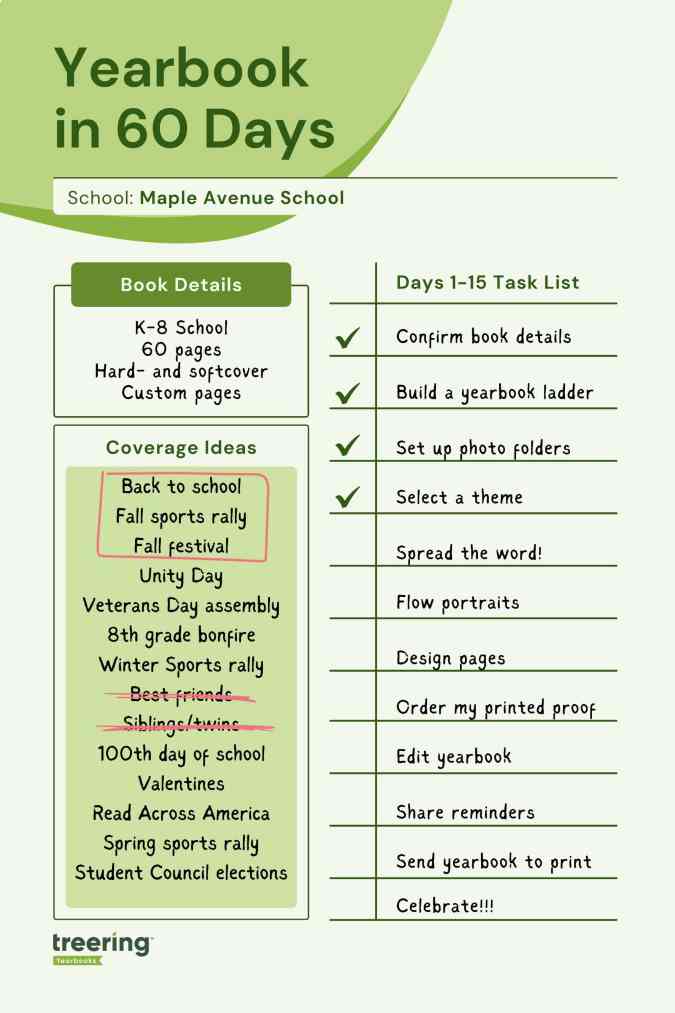
1. Confirm your book details
It’s tempting to jump into the glamorous yearbook tasks such as theme and design. There’s a little back-end work you need to do first for two reasons:
- Your dates will direct your workflow
- Your yearbook details determine the price of your yearbook
Dates
With Treering, you can change your dates at any time. Remember, your three-week turnaround begins once you hit Print Ready, and send your book to the printers.
For parents: custom pages deadline
Parents will see this date on their account, indicating when they should purchase the book or complete any customized pages. It doesn't impact the printing schedule.
Some parents {raises hand} need a little extra time and reminders to complete theirs. Treering recommends a cushion of about two weeks.
For editors: finish editing yearbook deadline and estimated delivery date
This is your one and only deadline for editing the book—and you set it! Select a date three weeks from when you want to distribute it.
You won’t be able to edit the delivery date directly. Treering automatically populates it by the date you choose for your deadline. If you need additional time to capture year-end events, no problem. Your three-week turnaround will align with your new deadline.
In part four, you’ll learn how to send your yearbook to print.
Pricing
The yearbook price will change in real time when you adjust the page count and cover finish. The best way to firm up your page count is to create a ladder (more on this below).
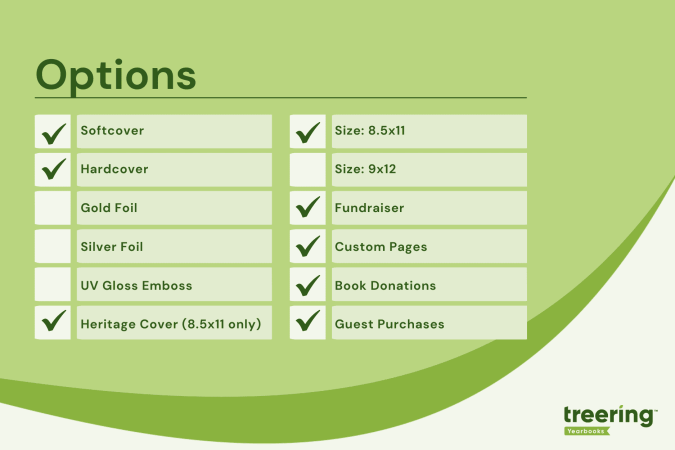
Shipping and index
Bulk shipping to the school is free. If you select this option, you choose how to receive your yearbooks:
- Sorted alphabetically
- Sorted by grade and then alphabetically
- Sorted by teacher and then alphabetically
Alternatively, many online or hybrid academies and schools electing to do a fall delivery choose the ship-to-home option. When parents order yearbooks, they also pay a flat rate shipping fee.
Book details resources
- Video: Chief Editor Dashboard
- Free Live Webinars: Treering’s Yearbook Club
2. Build a ladder
A ladder is a chart that represents the pages in a yearbook. It’s the industry-standard tool to help you stay organized. On it, you allocate a topic to each yearbook spread (that’s yearbook-ese for two facing pages).
Because yearbooks tell the story of the year, there isn’t a codified order to how things go. Typically, they include
- Academics: school distinctives, achievements, and activities
- Events: fundraisers, activities, performances, before- and after-school activities
- Organizations: clubs and teams
- People: student, staff, and faculty portraits
- Thematic content: larger books employ divider pages to separate sections
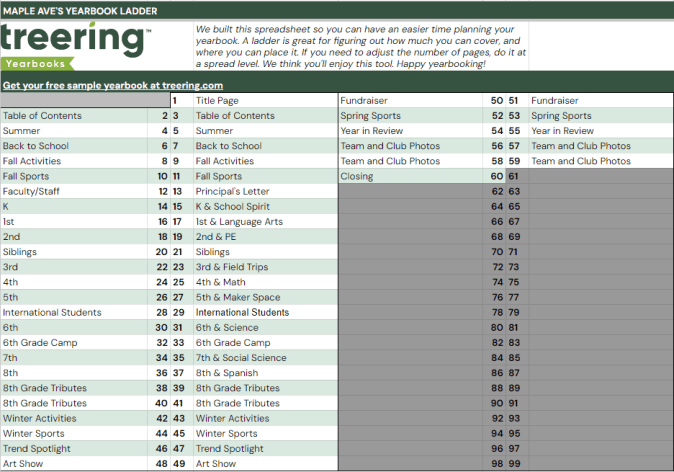
To build your ladder, look at the last few yearbooks and the latest school calendar.
- Brainstorm the non-negotiable events, sections (people, arts, sports), and yearbook traditions
- Brainstorm features, specials, and theme-related content
- Decide how you will organize the book
- Allocate spreads
We love doing this digitally because it can be fluid. If your page count is looking overwhelming because of time or budget, combine some topics. Remember to update your page count on your book details so it matches your plan.
Yearbook ladder resources
- Google Sheet: Free Yearbook Ladder Template
- Google Sheet: Example Ladders (there’s a separate tab for elementary, middle, K-8, and high school examples)
3. Set up photo folders
The best photo organization tip I can give came from Yearbook Hero Katie Parish. She said to create folders to mirror your ladder. This way, you know you are collecting content for every single spread you planned. And spoiler alert, your design process will look like this.

By investing the time to set up folders this way, you can simplify your workflow. Just open the corresponding folder and click, drag, drop, and done!
In the video below, you’ll see how to add folders and set up crowdsourcing features. Notice the Art Show folder is Editor Only. This means only you, the editor, can place photos in this folder. After activating their accounts, parents will see the yellow “public” folders and be able to share. At any time, you can make a folder Editor Only and vice versa.

In Part Two, we will give you five strategies to fill those shared folders with content so you can build your pages.
Photo organization resources
- Article: Creating Folders and Subfolders (this is one of those Editor-only resources, so you'll need to log in)
- Article: School Photos
4. Choose a whole-book look
The Styles menu is where it’s at: you can create font and photo presets, adjust your margins (#TeamMarginsOff), and select the theme for your yearbook. Because I have 60 days to create a yearbook, I am skipping all the customization options and selecting a pre-designed theme to give my yearbook a unified look.

For a cover-to-cover drag-and-drop experience, the design team recommends the following Treering themes:








Theme resources
- Google Slides: All Treering’s Yearbook Themes
- Blog Category: Theme Ideas and Inspiration
Remember, get to know your dashboard; it’s the first thing you see each time you log in. Part two of this series will outline the promotion tools built in the yearbook builder and start the design process.
Yearbook with a friend
You can also recruit team members to help you build and market the yearbook. With Treering, you can set permissions and assign pages to help delegate your workload. Additionally, parents, teachers, and students can help gather content and promote book sales.
Organization resources for yearbook teams

Teaching yearbook: graphic design
In my credential program, I missed the comprehensive graphic design, marketing, journalism, editing and proofreading, photojournalism, contract negotiation, and volunteer management track that would prepare me to be a yearbook educator. Over the years, an idea library on my classroom shelves slowly came about: other school's yearbooks, folders of magazine spreads worth emulating, Treering's Big Idea Book and Marketing Un-Stumped, plus gobs of digital files. If your yearbook advising journey is relatable, try these small changes that will make an impact on your book's visual look.
This blog was adapted from Yearbook Hero's Lauren Casteen's Teaching Yearbook: Graphic Design webinar. If you're interested in joining this professional community to grow your yearbook pedagogy or to score some PD hours, register for one of our free webinars on Zoom.
Graphic design self-analysis
On a scale of 1-5, how do you currently feel about teaching graphic design? Keep in mind teaching and doing are two different skill sets.
Mild, medium, or spicy?
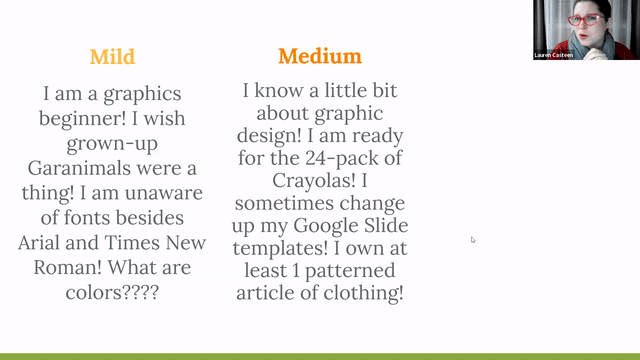
Below are some suggestions based on your self-reflection. This year, you may be Mild, and next year, you'll apply some of Casteen's tips and be Medium with a hint of Spicy.
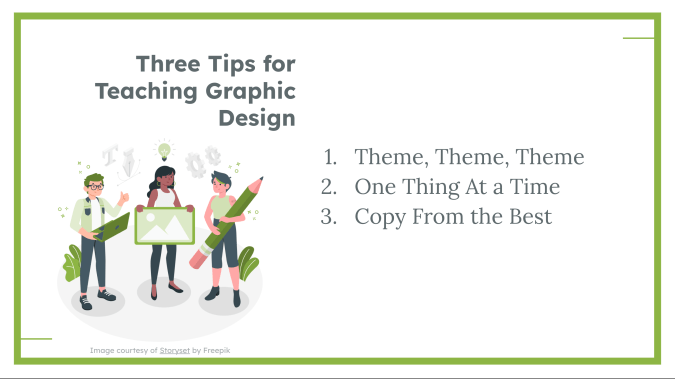
Yearbook theme
A theme helps keep your yearbook unified so it doesn’t look like a different person did every page (even if they did).
A theme does a lot of the graphic design work for you: it's like giving your students fill-in-the-blank notes as opposed to having them copy them by hand.
Lauren Casteen
Mild
Choose a yearbook theme from Treering's Theme Gallery. Commit to it by using it for your whole book: each theme package includes layouts, backgrounds, and graphics you can mix and match. Using powerful tools such as auto page layout, you can create a beautiful book while learning.
When you're ready, move to Medium.
Medium
Casteen falls into the Medium category: she says they start with a Treering graphics package that supports the verbal theme, and then they adapt it. The 2022 Polaris team wanted a newspaper feel to go with "A Year to Remember." The staff blended QWERTY, which had a modern media feel, and Venture, which is filled with vintage items and textures, to create their book.
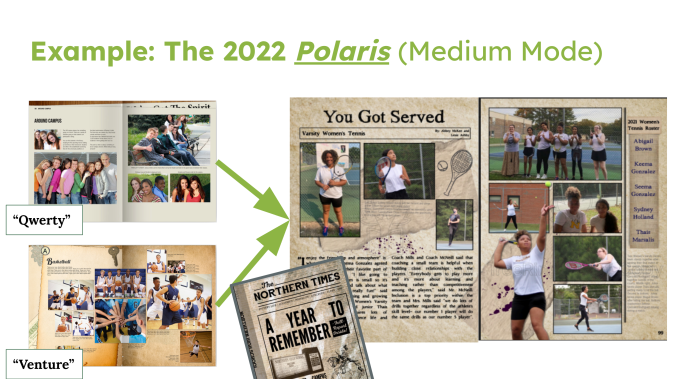
Spicy
You can design your own theme. Have students come up with a color palette using an online palette generator; use Treering’s font bank to match fonts. To build a unique look, consider including student drawings or artwork.
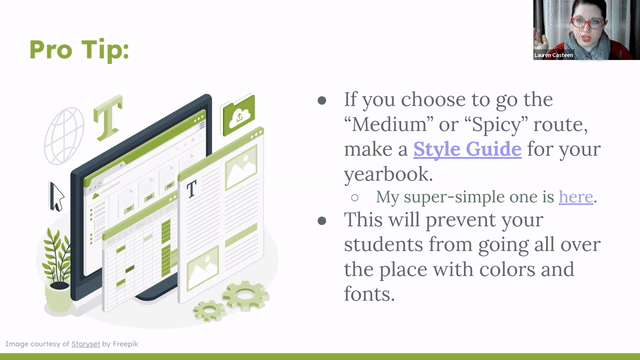
A style guide will help your designers remain focused. It will also help you, as an adviser, provide detailed feedback on how to improve the design. Here's Casteen's.
One graphic design concept at a time
Since graphic design is an entire professional field, and you could spend beyond four years in college studying it, there is entirely too much graphic theory and practice to complete in one semester or year of yearbook. By breaking it down, you can focus on what's essential for your team this year and build as you and your team grow. Here's how to do it:

Find the Golden Ratio blog and others on the design page of the blog.
Balancing first-year and returning yearbookers
If you have returners on your team, some of them may be Medium or Spicy, and that's OK. Now that you have some scaffolding, tailor your projects for your student by skill level.
You can revisit each topic each year with your returning staff members to make it more challenging. For example, maybe your newcomers are choosing a pre-made layout instead of doing it themselves, or maybe they are designing a layout for a module rather than an entire yearbook spread. Focusing on one specific skill at a time makes it easier for you as the teacher to differentiate.
Copy from the masters
The masters are "masters" for a reason. Whether it is a magazine ad or a social graphic, inspiration is out there. You can apply a photo treatment you saved from Pinterest on a divider page or emulate a car ad layout in your yearbook.

Get started in graphic design
Lastly, here are the action items from Casteen's session. Select one for your launch plan:
- Pick a theme if you haven’t (or maybe choose a few for your students to narrow down)
- Look through Treering blog articles to find a focus skill to teach
- Make yourself a Sandbox page and start playing around
- Find inspiration for a page to replicate
If you're interested in joining another of our working webinars, check out the entire Yearbook Club webinar schedule.

The one layout template you need
Yearbook coverage ideas might be our favorite topic: brainstorming ways to represent more students, resulting in a more authentic narrative of the school year. It could also mean more photos, interviews, and work for you. After a colleague shared Kingsbury Country Day School’s yearbook, a lightbulb went off. Yearbook coordinator Kara-Jane LaVoisne created the perfect layout that includes over 60 students, highlighting their impact and participation in school events.
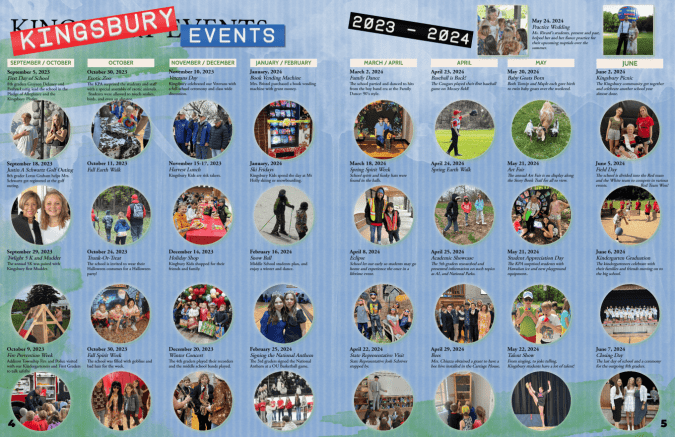
Why We Love This Template
This spread packs a punch because it covers a large span of time in little space. It covers 24% of the school across two pages. It showcases events that would not be covered elsewhere. This template is also well-designed: it’s clean and has multiple reader entry points.
Home For Smaller Events
Oftentimes, we have several photos that don’t fit on a larger spread. This is especially common in books that do not take advantage of modular design. LaVoisne took advantage of those moments to create a means to include them.
Versatility
While LaVoisne used this template for a school-specific year-in-review, you can use it once per section or season. For example:
- Fall, winter, and spring PTA or ASB events
- An overview of the sports seasons
- Semester rundown of student life
If you’re feeling ambitious and have the content, an hour-by-hour review of a major school event such as the talent show or homecoming weekend could be a showstopper spread for your yearbook.

What’s most important: your yearbook team celebrates the people in your campus community. This layout is just one way to cover more students in your yearbook. For more creative yearbook coverage inspiration, check out:

Table of contents tips
Form and function. A yearbook table of contents needs both. A well-designed one can make it easier for students and families to navigate, even in a smaller book. It’s another avenue to communicate your theme. And it’s also a layout worthy of those images that didn't make it elsewhere in the book.
Do You Need a Table of Contents in Your Yearbook?
Yes, especially, if you do not do an index. A table of contents is the proverbial road map or neon directional sign for your book. It’s also professional.
Normally, I’m not a proponent of “everyone else does it.” This is an exception. Yearbooks are reference books. Reference books have tables of contents. Therefore, yearbooks should have tables of contents. (Somewhere, my son’s logic teacher is smiling.)
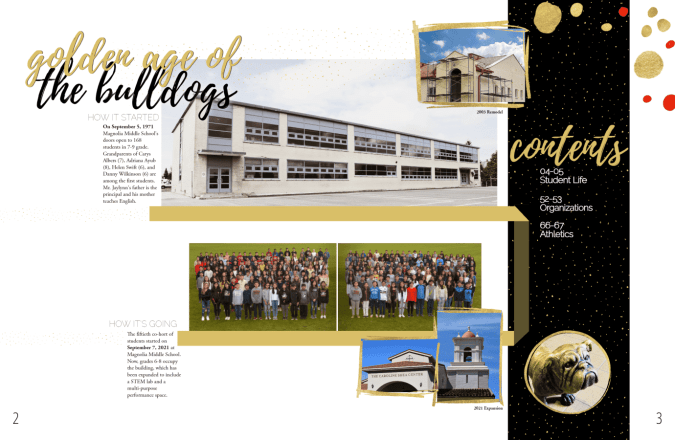
Tips for Small Yearbooks (<60 Pages)
If you're working on a smaller yearbook, here are a few additional things to keep in mind when designing your table of contents:
- Keep it Simple: Stick to the essentials and only include major sections or events in your table of contents.
- Use Space Wisely: You may not need a double-page spread; integrate your table of contents on the title page.
Tips for Larger Yearbooks (>100 pages)
For larger yearbooks, consider the following:
- Add Sub-Sections: Include sub-sections or categories to help readers navigate through the content more easily.
- Use Visual Cues: Incorporate visual cues such as icons or graphics to help readers quickly identify different sections of the yearbook. These should of course correspond to your theme.
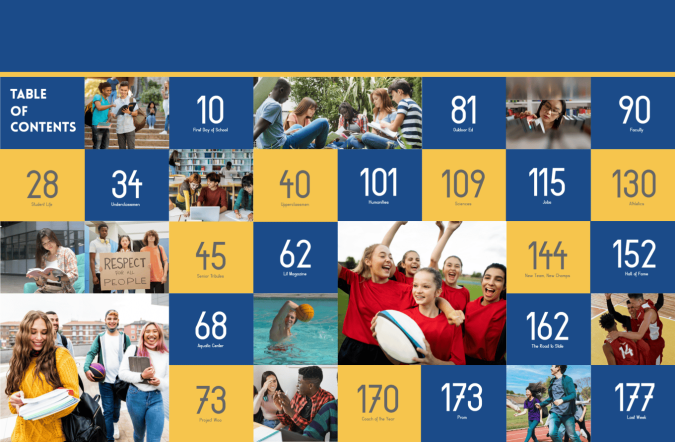
How Do You Arrange a TOC for YB?
It may be tempting to tackle this first since it spans the first few spreads of your yearbook. Wait! You may increase sections or move pages through the design process.
- Let Your Ladder Be Your Guide: A yearbook ladder is essential when planning your book and for creating the table of contents. Make sure your ladder and table of contents align.
- Determine the Level of Detail: At a minimum, include the major sections: people/portraits, events, clubs and organizations, athletics, and arts. Larger yearbooks may need to create sub-sections.
- Focus on Clarity: Ensure your sections and page numbers are easy to read and understand, even at a glance.
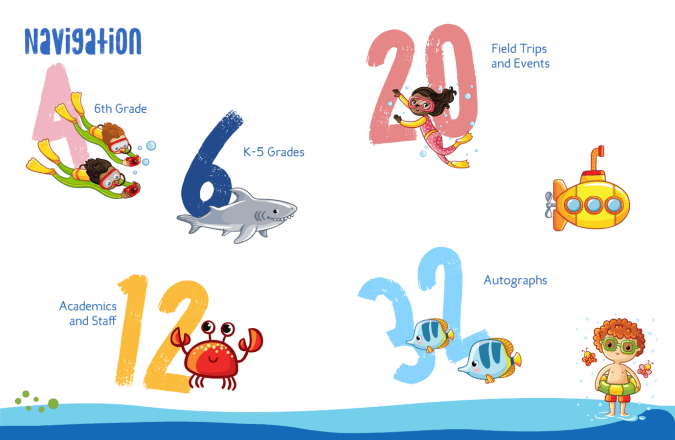
4 Tips To Integrate Your Yearbook Theme
Because every detail counts when creating your epic school yearbook, there are a few ways to apply your theme to your yearbook’s table of contents.
1. Use Theme Colors: Incorporate theme colors into the layout for text, borders, or background elements.
2. Include Theme Graphics: Add graphics or illustrations related to your yearbook theme to enhance the visual appeal. This could be icons, symbols, or images representative of theme elements.
3. Custom Fonts: Choose fonts that complement your yearbook theme and use them consistently throughout your table of contents. This will help tie the design together and create a cohesive look and feel.
4. Creative Section Titles: Get creative with your section titles and use language that reflects your yearbook theme.
A well-designed table of contents is a requisite element of a school yearbook, helping to guide readers through the content and enhance their overall experience.

Memory marvels 2024 custom page design contest winners
We love nothing more than seeing yearbooks personalized with each student's memories. Custom pages embedded within the pages of classmates, activities, and school-wide celebrations deliver more than memories. They celebrate the uniqueness of the individual holding the yearbook. Congratulations to all the parents who created and shared their designs. The following six wowed our panel of designers and yearbook parents to earn the top honors in either the K-8 category or high school one.
K-8 Custom Page Winners
First Place: Laura Dauley, IL
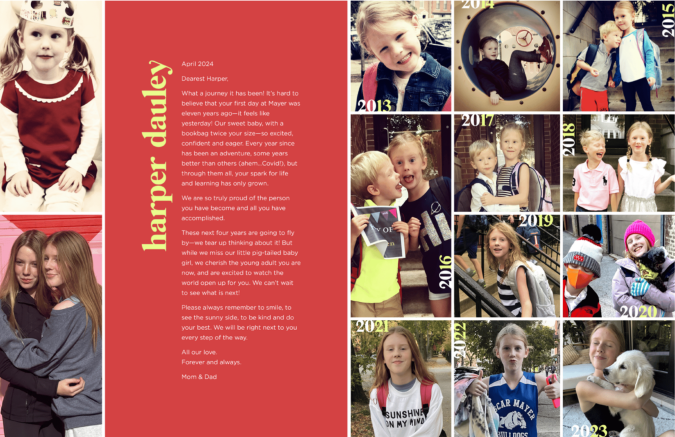
"I wanted to honor Harper’s eleven years at Mayer with custom pages that show her journey from beginning to end," Dauley said.
Why we loved it: this spread looks like it could be a magazine ad. It's clean. The photos have a strong alignment. Dauley's use of the canary for both Harper's name and the years adds balance where the polo shirt could have been a distraction. The negative space in the parent message is a place of rest for the eyes among the thirteen photographs.
Second Place: Nicki Prettol, TX
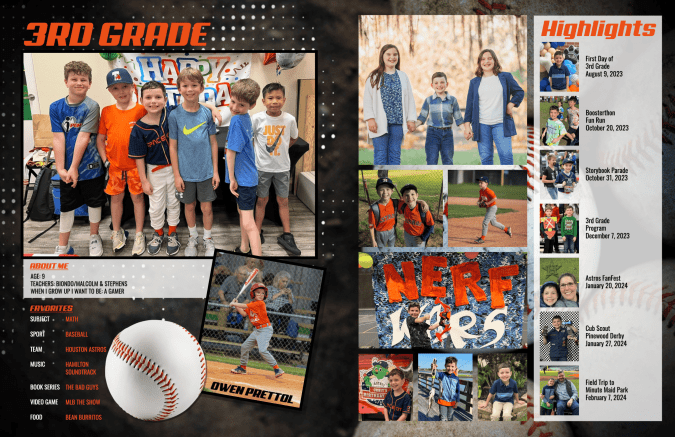
Since her son loves baseball, "it seemed fitting to give him baseball-themed custom pages," Prettol said.
Why we loved it: Again, the use of color made the designers on the judging panel smile: the orange is in both photos and text, unifying the design. From the stats on the left-facing page, to the highlights on the right, Prettol used a little text to make a big impact.
Third Place: Colleen Packman, TX
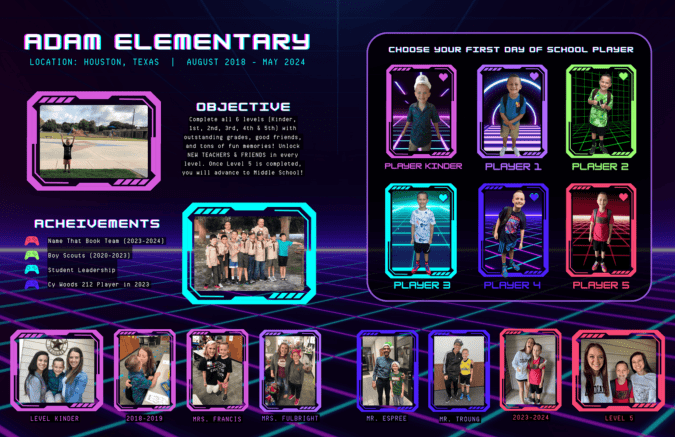
"As his elementary 'mission' comes to an end," said Packman, "I couldn't think of a better way to represent his time than to relate it to one of his favorite hobbies."
Why we loved it: E-sports and cyberpunk are trending in the design world. That alone made us take a second, third, fourth (you get it) look. She used subheadings to organize the content in a game UI.
High School Custom Page Winners
First Place: Ethan Scrogham, IL
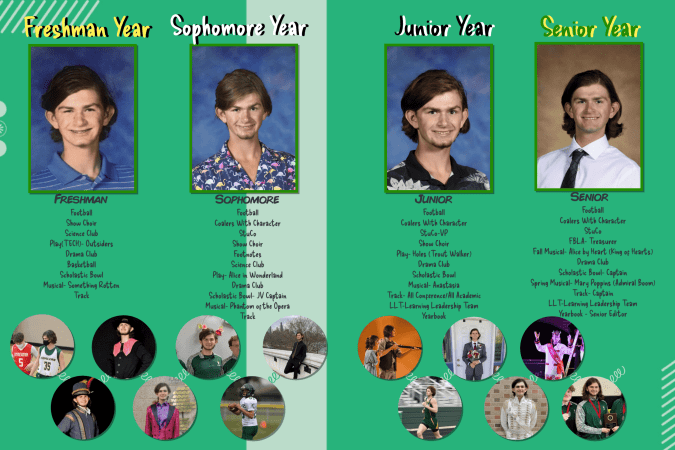
"This year I am a senior and wanted to put something to show all of my accomplishments and activities," said Scrogham. He compiled this spread using photos from the past four years.
Why we loved it: The story. Scrogham's involvement increased each year (as did his smile). Seeing a freshman on the court wearing a mask grow into a campus leader is a portrait of resilience.
Second Place: Amie Kelp, MI
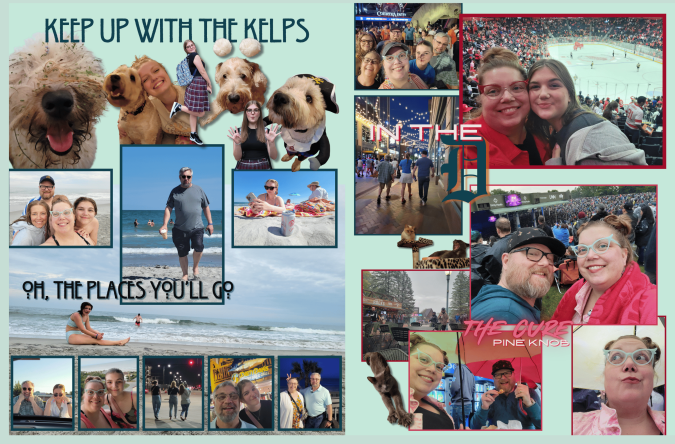
"This [creating a custom page] is the best way to personalize a book possible," Kelp said. She created over ten to celebrate her daughter and the memories they made.
Why we loved it: The title made us smile, as did the pet photos. Kelp used the border color to visually connect related adventures, which brought some order to the collages.
Third Place: Kirsten Megaro, NJ

Megaro said, "As homeschoolers, most of life is part of our learning. This first spread gives an overview of our year." Each child also has their own spotlight custom pages spread for their personal memories.
Why we loved it: This spread shows the impact three people can have on their family and community. Megaro matched the photo styles bringing unity to the various backgrounds and locales. She also made the busy background work by using white text blocks with transparency.

Layout legends 2024 design contest winners
The 2024 Design Contest Winners are the most diverse collection to date.
“Every year, our editors craft spreads that wow and inspire our judging staff.” said Marketing Manager Megan P.
With nearly 50 creatives combing through the submissions, each looked for their ideal. Purists advocated for hierarchy and balance, journalists dug through each piece of copy for the stories, graphic designers sought out-of-the-box applications, and empaths soaked in every moment. The three winners for each category are below, plus some favorites we had to showcase.
Lone Rangers (Teams of One or Two)
Solo yearbook coordinators hold a special place in our hearts; that’s why they have their own category. They tackle both administrative and creative tasks. They are the face and hands of their yearbook programs. And they shared some legendary spreads.

First Place Winner: Arianna Fang, Thomas Russell Middle School
Arianna Fang displays an understanding of how repetition and consistency enhance design. Fang uses several colors in the swirls and accents. They all share a palette, bringing harmony. One judge called out the “pop” the palette brings to each page.
“I love the use of color and design throughout this spread,” a second judge said. “It immediately sucked me in and made me want to read the page.”
Her spread uses elements of art to showcase students at work. From photo frames that look like brushstrokes to the dotted stroke details on the edging of a few photos, there is a DIY aspect. She also repeats the purple accents as a wash and leopard spots in different levels of transparency, bringing balance.
“Even with all the elements on the pages, it has good movement and interest,” a judge said.
“Art is expressing ourselves,” Fang said. “And if you believe in the beauty of art, you can achieve wonders.”
We couldn’t agree more.
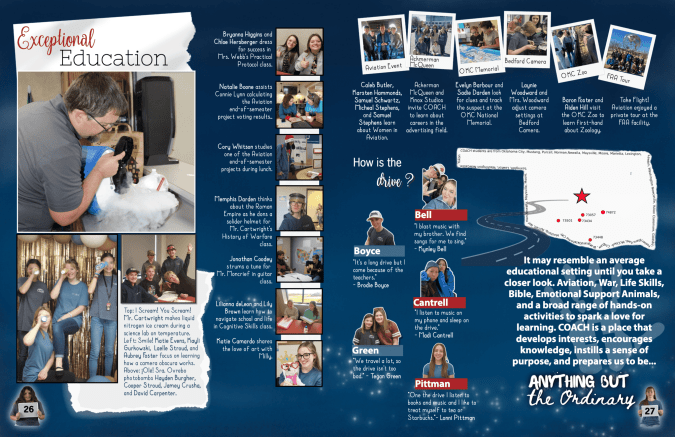
Second Place Winner: Karen Goodchild, COACH
Karen Goodchild had us at her brilliant use of modular design. Her spread has a variety of stories, excellent hierarchy, and multiple reader entry points. Several judges called out the detail of students holding up the page numbers.
“This entry includes a lot [over 60] of students without overwhelming the spread,” a judge said.
A dark background could be problematic. Goodchild demonstrates mastery of contrast by ensuring all the copy is readable.
“I appreciate the balance of traditional yearbook content with fun graphics and content,” a judge said.
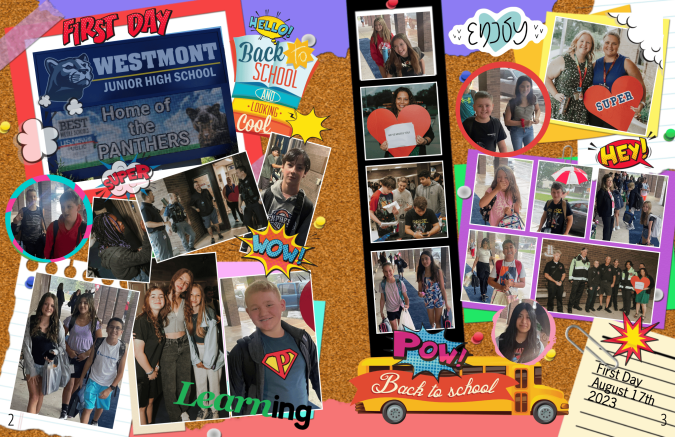
Third Place Winner: Sabrina Reimann, Westmont Junior High School
First day traditions at Westmont Junior High include red carpet and music on campus. “Our 6th graders are always nervous, and we make it welcoming for them,” Sabrina Reimann said.
This spread captures that energy.
The DIY look is a huge graphic design trend. It resonated with several judges who said, “The bulletin board vibes take me right back to the first day of school” and “This looks like my school yearbook.”
The layered effect helps the art and photos work together.
“It is a fantastic representation of what you can design with Treering's available background and graphic options,” a judge said.
Group Gurus (Teams of Three or More)
While yearbook clubs and classes use teamwork to create their books, they do it while balancing delegation, learning communication, and trusting one another. The top three team collaborations had little in common stylistically. Where the won the hearts of the judges is in their storytelling.
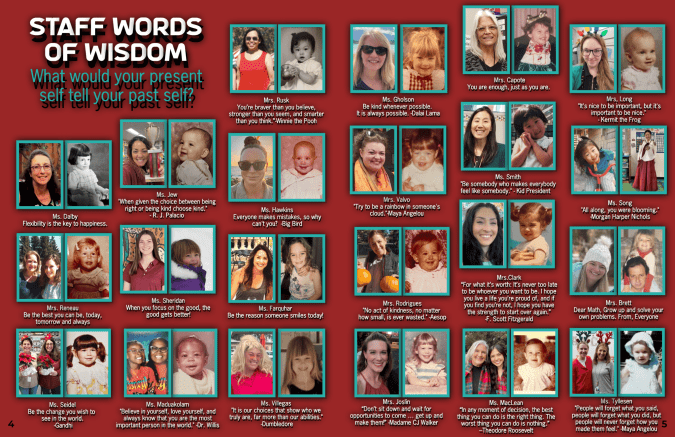
First Place: Jensen Ranch Elementary
Many judges-slash-parents had an emotive reaction to seeing these role models and campus influencers on display in this way.
“Students are going to revisit these pages because not only are they able to see their teachers’ photos as a blast from the past, but their words are influential,” a judge said.
These “relatable” and “heartwarming” “pearls” (the judges’ words) are the result of the yearbook team’s efforts. They collected the quotes and photos, a labor-intensive task in itself, and organized them in the winning design with uniform sizing to keep such a content-rich spread from becoming cluttered.
Adviser Johnetta Maduakolam said, “It captures the essence of our school community from the past to the present.”
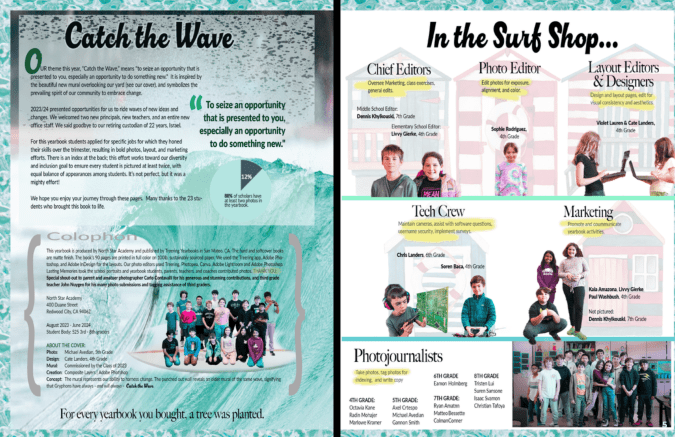
Second Place: North Star Academy
Ownership.
“None of the 22 students [in the yearbook program] actually chose to be there,” Adviser Carol Landers said, “Once we got the Treering software, the excitement kicked in, and kids started asking for jobs.”
Now look at them. From theme explanation and the colophon to the stats (hello, 86% in the yearbook 2x or more) and job descriptions, the team at North Star Academy used the space to educate others on their campus about the facets of yearbooking.
From a visual perspective, there’s so much more to love about this spread:
- “Great mix of images and text to carry the reader’s eye through the spread.”
- “Colors are cohesive and match a beachy theme.”
- “Loved seeing the theme subtly applied to the background, colors, graphics, and text.”
- “Great use of space, equal and consistent spacing, and font choices.”
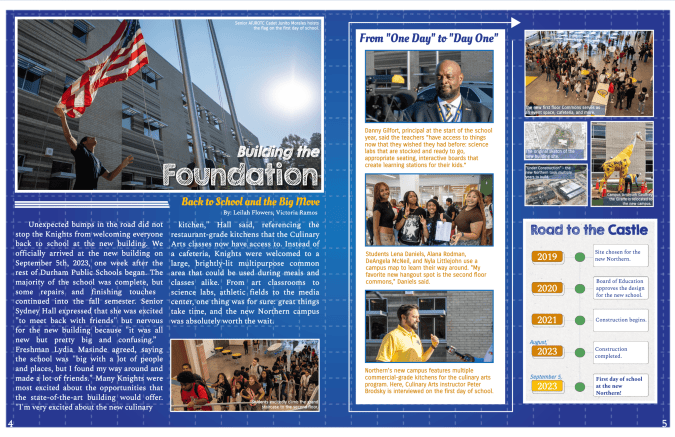
Third Place: Northern High School
Our love of this spread stems from the fact that everything points back to the theme:
- Wordplay
- Blueprint background “pulls it all together“
- Storytelling
“I love the story that this spread is telling,” a judge said. “You can tell that the school is building and making a positive change for the students.”
The team at Northern took care to design each module to fit the content. For example, the timeline is a graphic quick read, and the first-day saga is a feature story with multiple perspectives. The photography is also diverse: action, headshots, groups, and in-progress views.
“It gives readers a great sense of this school’s big move,” another judge said.
Design Contest Honorable Mentions
The above slidwshow contains designs from
- Karen Goodchild, COACH
- Matt Jones, Mission Oak High School
- Carren Joye, Academy Days Co-op
- Carol Landers, North Star Academy
- Yuri Nwosu, Lennox Middle School
- Brooklyn Vanderhey, Brookings-Harbor High School
- Bri Webb, Rooted Christian Co-op

